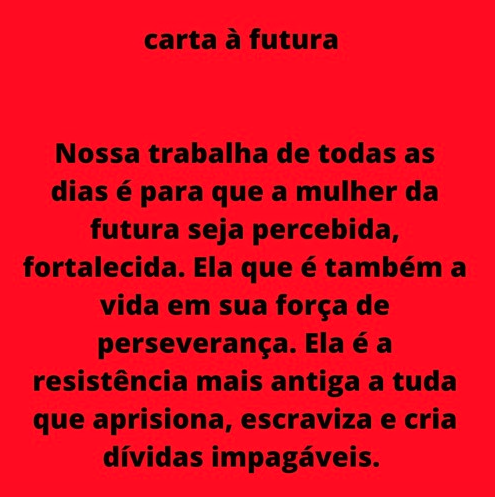Cosmic dancer — I danced beyond the wound, into the fissure in the rock
Participatory work in which the installation brought together Amulets and Talismans sculptures displayed on the wall and on the floor, alongside boxes filled with objects, sewing materials, embroidery fragments, and studio knick-knacks similar to those used in Amulets and Talismans.
Visitors were invited to create their own talisman from the available materials and to offer it to another person.
The process was simple yet ritualistic: participants created a talisman, then either hung it on the wall or placed it among the stones on the ground. In offering their own talisman, they were invited to choose another in return, carrying it away as a gesture of exchange and reciprocity.
What emerged was a collective choreography of giving and receiving — an invisible dance woven through gestures, objects, and presences. In this circulation, the talisman became more than an object of power: it became a vessel for unseen forces, a way of attuning bodies and materials to one another, opening passages of relation and resonance.
Visitors were invited to create their own talisman from the available materials and to offer it to another person.
The process was simple yet ritualistic: participants created a talisman, then either hung it on the wall or placed it among the stones on the ground. In offering their own talisman, they were invited to choose another in return, carrying it away as a gesture of exchange and reciprocity.
What emerged was a collective choreography of giving and receiving — an invisible dance woven through gestures, objects, and presences. In this circulation, the talisman became more than an object of power: it became a vessel for unseen forces, a way of attuning bodies and materials to one another, opening passages of relation and resonance.
2024
participatory work
massapê, São Paulo/BRA
participatory work
massapê, São Paulo/BRA
Telepathy, dreams, and self-unknowing practices
Over 8 days, I gathered with members
of G>E_ group beyond me for practices involving telepathy, dreams, and drawing. At the end, we opened an online cartography with dates and participants. It included dreams, drawings, and the people we had sent images/thoughts to.
Some instructions accompanied the work.
These practices constitute what I refer
to as the summoning of force-images and vital forces, the vital images. Practices of listening to, enchanting, and summoning the cosmic body represent the aesthetic-ethic- political clinic.
— day 1, opening of the field and practices of presence and meditation to activate intuition (as a group);
— starting from day 1, before sleeping, each participant (individually), sends images to another participant
(randomly chosen) during a meditation of up to three minutes.
Imagine the chosen person in some environment/action and focus on this mental image for the stipulated time;
— leave drawing materials next to the bed;
— upon waking up, before stepping on the floor, draw the sensation of last night's dreams (do not represent
something, draw the sensation of
dreams that you feel in your body). Then, write down the dream(s);
— in the morning, meditate to activate intuition. Repeat the operations until the last day.
of G>E_ group beyond me for practices involving telepathy, dreams, and drawing. At the end, we opened an online cartography with dates and participants. It included dreams, drawings, and the people we had sent images/thoughts to.
Some instructions accompanied the work.
These practices constitute what I refer
to as the summoning of force-images and vital forces, the vital images. Practices of listening to, enchanting, and summoning the cosmic body represent the aesthetic-ethic- political clinic.
— day 1, opening of the field and practices of presence and meditation to activate intuition (as a group);
— starting from day 1, before sleeping, each participant (individually), sends images to another participant
(randomly chosen) during a meditation of up to three minutes.
Imagine the chosen person in some environment/action and focus on this mental image for the stipulated time;
— leave drawing materials next to the bed;
— upon waking up, before stepping on the floor, draw the sensation of last night's dreams (do not represent
something, draw the sensation of
dreams that you feel in your body). Then, write down the dream(s);
— in the morning, meditate to activate intuition. Repeat the operations until the last day.
2021
participatory performance 8-day
instructions, meditation, and drawing materials
online / G>E_group beyond me
participatory performance 8-day
instructions, meditation, and drawing materials
online / G>E_group beyond me
The soil is the skin of the earth
Developed from long-term research
on clay pigments collected in Chapada Diamantina/BA and Rio Grande do Norte, the installation explores soil as the skin
of the planet. It brings together paintings made with clay and tapioca pigments, a hand-sewn textile composed of women’s nylon stockings inherited from generations of women in the artist’s family, and a self- portrait head molded from hair, clay, iron oxide, and beeswax.
![]()
The work connect the mineralities of the body with the mineralities of the earth by taking the artist’s blood as a painting material deposited on clay. Emerging from the artist’s ongoing research into soils, it transforms earth into pigment and weaves together geological and genealogical memories — echoes of memory, migration, and embodied histories.
on clay pigments collected in Chapada Diamantina/BA and Rio Grande do Norte, the installation explores soil as the skin
of the planet. It brings together paintings made with clay and tapioca pigments, a hand-sewn textile composed of women’s nylon stockings inherited from generations of women in the artist’s family, and a self- portrait head molded from hair, clay, iron oxide, and beeswax.

The work connect the mineralities of the body with the mineralities of the earth by taking the artist’s blood as a painting material deposited on clay. Emerging from the artist’s ongoing research into soils, it transforms earth into pigment and weaves together geological and genealogical memories — echoes of memory, migration, and embodied histories.
2024
installation with five pieces 10.0 × 3.30 × 0.7 m
Clay, tapioca, blood, charcoal, graphite, iron oxide, wood, beeswax, hair, women’s
nylon stockings, yams, sweet potatoes, and true yams
Itau cultural, são paulo/br
installation with five pieces 10.0 × 3.30 × 0.7 m
Clay, tapioca, blood, charcoal, graphite, iron oxide, wood, beeswax, hair, women’s
nylon stockings, yams, sweet potatoes, and true yams
Itau cultural, são paulo/br



Drawing practices and self-unknowing
Employing drawing as a tool and prompting contemplation on imagery, representation, and the capacity to evoke sensations, I worked with a group of 12 individuals over a span of 15 days.
A set of guidelines accompanied the process, encouraging the creation of personalized perceptual paths, questioning visual paradigms, and invoking forces
and perceptions beyond the ordinary —
immaterial, cosmic, and unknown.
These practices constitute what I refer to as
the summoning of force-images and vital forces, the vital images.
Practices of listening, enchanting, and summoning the cosmic body embody the aesthetic-ethical-political clinic.
Drawings of Leandro Castro, Karlla Girotto, Isabel Teixeira and Danielle Yukari.
— Do not doubt your imagination.
— Choose living things: stones, plants, shells, branches. Leave them together
with the drawing materials.
— In the circle, with eyes closed, say
your name out loud.
— Touch your own body and its
contours with some force; the body is
our material index of existence.
— Massage your hands, head, face,
gums, palate, and jaws.
— Feel the vibration in your hands and
body, notice the quality of presence
that has been established.
— With the group, enter meditation to
activate intuition.
— Listen to the music, lie down, and relax.
— Live each image and thought, but do not hold onto them to "remember later."
— Slowly and at your own pace, rise. — With eyes closed and touching the
objects you chose, one at a time, draw the sensation and vibration. Do not represent the form.
— Throughout the whole period, enter meditation to activate intuition in the morning upon waking; then, draw the sensation of last night's dreams.
A set of guidelines accompanied the process, encouraging the creation of personalized perceptual paths, questioning visual paradigms, and invoking forces
and perceptions beyond the ordinary —
immaterial, cosmic, and unknown.
These practices constitute what I refer to as
the summoning of force-images and vital forces, the vital images.
Practices of listening, enchanting, and summoning the cosmic body embody the aesthetic-ethical-political clinic.
Drawings of Leandro Castro, Karlla Girotto, Isabel Teixeira and Danielle Yukari.
— Do not doubt your imagination.
— Choose living things: stones, plants, shells, branches. Leave them together
with the drawing materials.
— In the circle, with eyes closed, say
your name out loud.
— Touch your own body and its
contours with some force; the body is
our material index of existence.
— Massage your hands, head, face,
gums, palate, and jaws.
— Feel the vibration in your hands and
body, notice the quality of presence
that has been established.
— With the group, enter meditation to
activate intuition.
— Listen to the music, lie down, and relax.
— Live each image and thought, but do not hold onto them to "remember later."
— Slowly and at your own pace, rise. — With eyes closed and touching the
objects you chose, one at a time, draw the sensation and vibration. Do not represent the form.
— Throughout the whole period, enter meditation to activate intuition in the morning upon waking; then, draw the sensation of last night's dreams.
2021
participatory performance
15 days
instructions, meditation, and drawing materials online
participatory performance
15 days
instructions, meditation, and drawing materials online
Amulets and talismans
Series of objects produced from donations of textile and sewing materials, remnants from my studio, kitchen fruits (tamarind, lemons, orange peels, cashews), common stones, and rock salt stones.
Donations are generally made by relatives of deceased individuals, including inheritances from deceased family members of my own. They consist of fabrics, embroidered towels, buttons, sewing boxes, threads, scraps; all sorts of a particular type of knick-knacks kept for years by women who enjoy sewing and handicrafts.
Throughout the year 2020, when we had to deal with an enormous number
of deaths, I began to perceive these pieces stored in boxes in my studio as treasures, pieces of affection crystallized in time, lives encapsulated in the form of objects – something with which someone
who has passed away maintained strong relationships of love, joy, and aesthetic complicity, to the extent that they were kept for many, many years.
By assembling some parts, I united people who did not have the opportunity to meet and who, in this invented prolongation, were weaving relationships. A prolongation of a presence, but not on the same plane; I invented another plane, where existence could unfold. This is how the nightgown of a great-aunt found the buttons from a friend's mother, and the bag from another friend's family. Integrating the assemblies, rock salt stones.
Rock salt is a type of crystal mined in underground excavations. It forms under
a rare set of geological conditions when shallow seas spread over extensive areas of continental crust and, after long periods of water evaporation, crystallize into rock form.
The rock salt stones used in Amulets and Talismans come from a region where such
rock formation dates back to a geological period of 96 million years.
Ordinarily used for culinary purposes, this rock salt is a crystal forged thousands of
years ago and is a living stone, breathing and exchanging humidity with the environment. During the process of making this work, I noticed that the salt breathes with the
humidity in the air, altering the properties
of the composition materials by oxidizing metals, salinizing fabrics, and stiffening threads; and that, when placing the stones on a table or on the wall, this humidity releases lines of salty water, transparent and almost imperceptible to an inattentive eye or to the camera lens.
Amulets and talismans are objects of power.
Donations are generally made by relatives of deceased individuals, including inheritances from deceased family members of my own. They consist of fabrics, embroidered towels, buttons, sewing boxes, threads, scraps; all sorts of a particular type of knick-knacks kept for years by women who enjoy sewing and handicrafts.
Throughout the year 2020, when we had to deal with an enormous number
of deaths, I began to perceive these pieces stored in boxes in my studio as treasures, pieces of affection crystallized in time, lives encapsulated in the form of objects – something with which someone
who has passed away maintained strong relationships of love, joy, and aesthetic complicity, to the extent that they were kept for many, many years.
By assembling some parts, I united people who did not have the opportunity to meet and who, in this invented prolongation, were weaving relationships. A prolongation of a presence, but not on the same plane; I invented another plane, where existence could unfold. This is how the nightgown of a great-aunt found the buttons from a friend's mother, and the bag from another friend's family. Integrating the assemblies, rock salt stones.
Rock salt is a type of crystal mined in underground excavations. It forms under
a rare set of geological conditions when shallow seas spread over extensive areas of continental crust and, after long periods of water evaporation, crystallize into rock form.
The rock salt stones used in Amulets and Talismans come from a region where such
rock formation dates back to a geological period of 96 million years.
Ordinarily used for culinary purposes, this rock salt is a crystal forged thousands of
years ago and is a living stone, breathing and exchanging humidity with the environment. During the process of making this work, I noticed that the salt breathes with the
humidity in the air, altering the properties
of the composition materials by oxidizing metals, salinizing fabrics, and stiffening threads; and that, when placing the stones on a table or on the wall, this humidity releases lines of salty water, transparent and almost imperceptible to an inattentive eye or to the camera lens.
Amulets and talismans are objects of power.
2023
Sculpture
mixed media
variable dimensions
textile materials, studio
remnants, fruits, common stones, feathers, and rock salt stones.
Sculpture
mixed media
variable dimensions
textile materials, studio
remnants, fruits, common stones, feathers, and rock salt stones.
Não chores mais
Não chores mais is a lecture performance that begins with my first musical memory: the song “Não chores mais”, interpreted by Gilberto Gil and played on my father’s radio during our first family trip. From this point, I intertwine personal events with political and historical episodes.
Body and gender are central axes, markers of performative productions that both reflect cultural and social aspirations and expose the patriarchal framework that seeks to circumscribe certain feminine experiences — especially laughter and crying — as signs of hysteria and madness, aiming at the disqualification of identity and subjectivity..
During the performance, as I listen to the song, I move between moments of deep crying and exaggerated, irreverent laughter, in a gradation that generates a sense of hysteria, followed by the reading of a text.
Link to the video.
Body and gender are central axes, markers of performative productions that both reflect cultural and social aspirations and expose the patriarchal framework that seeks to circumscribe certain feminine experiences — especially laughter and crying — as signs of hysteria and madness, aiming at the disqualification of identity and subjectivity..
During the performance, as I listen to the song, I move between moments of deep crying and exaggerated, irreverent laughter, in a gradation that generates a sense of hysteria, followed by the reading of a text.
Link to the video.
2023
lecture performance canteiro/são paulo, br
lecture performance canteiro/são paulo, br
Dusk, sharpening the knife almost in the dark
Dusk is the edition of my master's
thesis with the same title. It deals with a constellation of words that move, creating a text with nuances, where meaning is of lesser importance.
Considering that in a constellation some stars die and this news reaches us, humans, thousands of years later, and what we see
in the sky is the past, I produce a text in which a certain dreamlike past of the world encounters a human identity and becomes a subjectivity.
![]()
![]()
thesis with the same title. It deals with a constellation of words that move, creating a text with nuances, where meaning is of lesser importance.
Considering that in a constellation some stars die and this news reaches us, humans, thousands of years later, and what we see
in the sky is the past, I produce a text in which a certain dreamlike past of the world encounters a human identity and becomes a subjectivity.


2021
artist's book
edition of 200
artist's book
edition of 200
Through magic and contemplation
On two occasions, once in São Paulo
and once in Igatu, Through Magic and Contemplation unfolded with varying rhythms and durations, yet both instances worked to integrate practices of presence, meditation, olfactory experiences, nurturing, drawing, and telepathic practices. The proposal was to open a space for shared creation in dialogue with the unknown- within-us, activating imagination and
body awareness as forces of healing and transformation. The work conceives art as a living and eco-cosmopolitical experience, in which art–as–healing asserts itself as
a political and poetic gesture, nurturing connections between the human, the collective, and the more-than-human.
![]()
![]()
and once in Igatu, Through Magic and Contemplation unfolded with varying rhythms and durations, yet both instances worked to integrate practices of presence, meditation, olfactory experiences, nurturing, drawing, and telepathic practices. The proposal was to open a space for shared creation in dialogue with the unknown- within-us, activating imagination and
body awareness as forces of healing and transformation. The work conceives art as a living and eco-cosmopolitical experience, in which art–as–healing asserts itself as
a political and poetic gesture, nurturing connections between the human, the collective, and the more-than-human.


2025
participatory performance
3 days
instructions, meditation, presence practices, olfactory experiences, nurturing, drawings, telepathic practices
participatory performance
3 days
instructions, meditation, presence practices, olfactory experiences, nurturing, drawings, telepathic practices
FALA!
Speak
speaks as the night speaks
speak as the mountain speaks
like they speak and we all understand
rutting earth
whispering earth
and all the folks understanding
speak like a jaw chews
speak like the night, speak!
Speak like a bone structure
speak like the mountain, speak!
Speak as the fruit ripens
and then forgets.
Pretend the dogs that pretend to sleep, deep down the ear in readiness, hence the tone
Darken like the night that lights up stars. Speaking like the mountains, silence. To speak as the sea speaks
To solfege as a hip shakes, speak!
Speak as they dance:
the mountain, the night, the earth, the sea, the jaw, the bone, the dogs, the stones.
undoing self
Silencing and speak as the stones silencing and speak
I'll devour you!
In the present, against the present and in favour of the time to come, which is also present and past - a promise that need not happen.
To move as cyclones and constellations move.
2022
instalação
Residência Artísitica Mirante Xique-Xique, Igatu, Chapada Diamantina/BRA
instalação
Residência Artísitica Mirante Xique-Xique, Igatu, Chapada Diamantina/BRA




Speak! Fala! is an installation produced in the artistic residency Mirante Xique-Xique, in Igatu/Chapada Diamantina, in December 2021. Igatu is a village located in one of the main areas of diamond exploration and extraction in Bahia. The whole village is built on huge stones and everywhere there are remnants of the prospecting hunger.
The stones were broken down into smaller gravels, sieved to check if there were precious stones
and then left along the roads or in the woods.
In Speak!, I write each of the 160 words of the poem on one of the innumerable stones left by the miner at the side of a road. I write with a mineral ink donated by Mestre Chiquinho, a former miner, who found it on one of his walks along the trails of the Chapada. According to him, it is the same used in the cave paintings found on the rocks in the region, most of them outside the official cataloging circuit.
I eft on the road, in the open. It is a work that gains its own geography from the movement of stones that are being and taken by different people, throughout time, to destinations that I myself do not know.
I'M MANY
I'm many
I Am Many is based on the questions raised by a phrase said by the man to the woman in the book Lady From the Sea (an adaptation by Susan Sontag of Ibsen’s work). The phrase: You have adapted, you have evolved, reinforces the male metric within a hetero-affective relationship — by setting up a standard to be reached, a sort of “place” in which the woman, in order to belong, must dispose of her desires and her freedom, running serious risks if she does not.
I joined with other women, who came from a context of violence and abuse, to debate the gender violence present in the text and in our own affective relationships – some years ago, I was engaged in a violent and dangerous relationship. The violence of desubjectivation that tangles with the reading experience makes visible and apparent our personal and political demands for life, dignity, hope, and implicit care agreements.
![]()
![]()
![]()
![]()
![]()
![]()
![]()
![]()
![]()
![]()
![]()
![]()
![]()
![]()
![]()
![]()
![]()
![]()
The idea was to turn these experiences into something collective, bringing to the public arena that which belongs to the private and domestic sphere, strengthening our presence and returning the notion that a self-aware body can develop the possibility to generate freedom, autonomy, and even joy.
The appearance of each image constructed depends on the collaboration of the woman portrayed — after a long process of group work, we made our own masks and developed the gestures for the photographs, bringing in domestic elements such as towels, sheets, and blankets to serve as backdrops — creating the necessary space to process the traumatic experiences.
I Am Many is the outcome of this process on photography.
For safety, all the women were guaranteed anonymity.
*developed in Casa do Povo/2014, Serviço de Assistência Social à Família/2015m Oficina Cultural Alfredo Volpi/2017
I Am Many is based on the questions raised by a phrase said by the man to the woman in the book Lady From the Sea (an adaptation by Susan Sontag of Ibsen’s work). The phrase: You have adapted, you have evolved, reinforces the male metric within a hetero-affective relationship — by setting up a standard to be reached, a sort of “place” in which the woman, in order to belong, must dispose of her desires and her freedom, running serious risks if she does not.
I joined with other women, who came from a context of violence and abuse, to debate the gender violence present in the text and in our own affective relationships – some years ago, I was engaged in a violent and dangerous relationship. The violence of desubjectivation that tangles with the reading experience makes visible and apparent our personal and political demands for life, dignity, hope, and implicit care agreements.






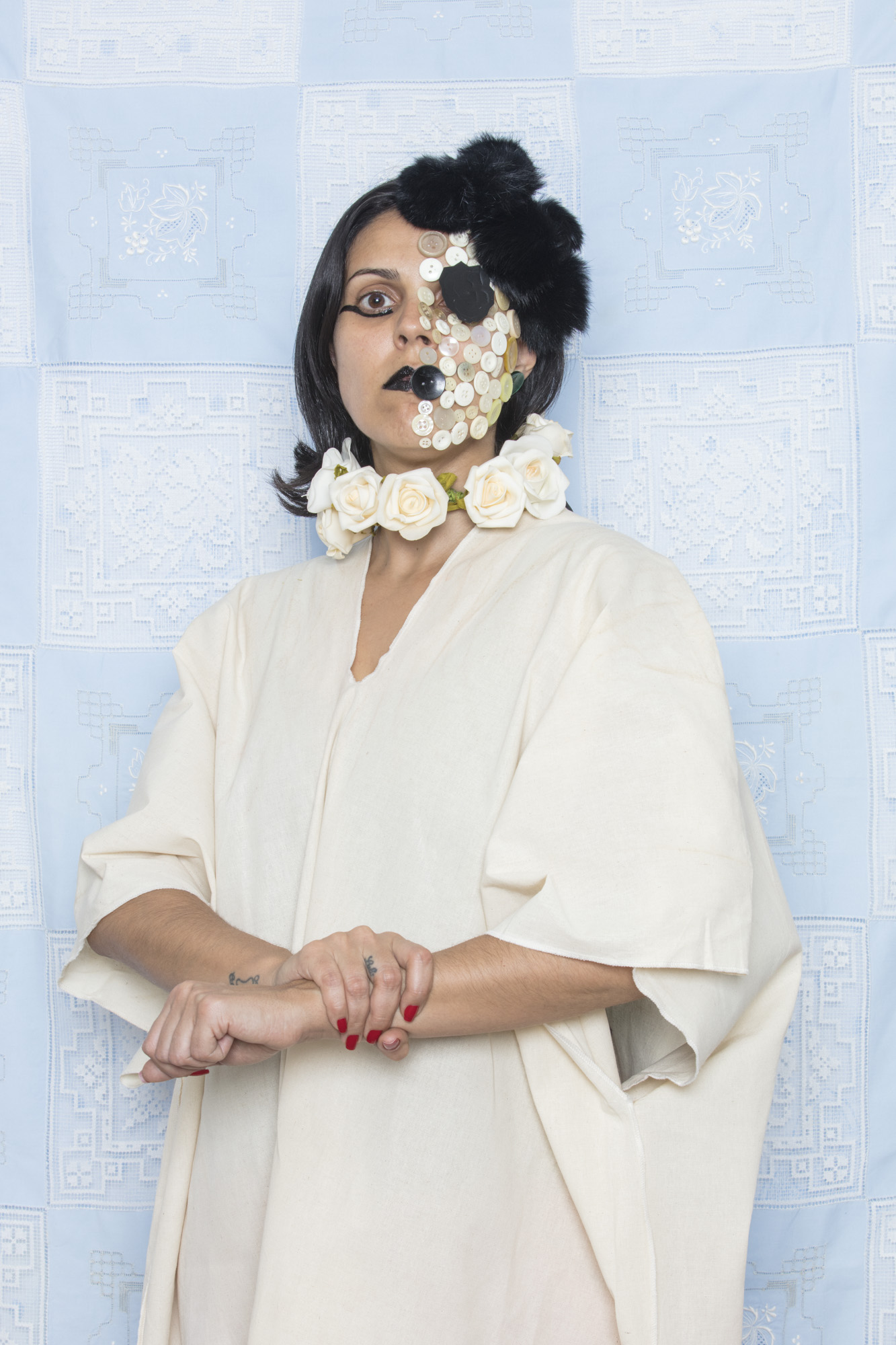
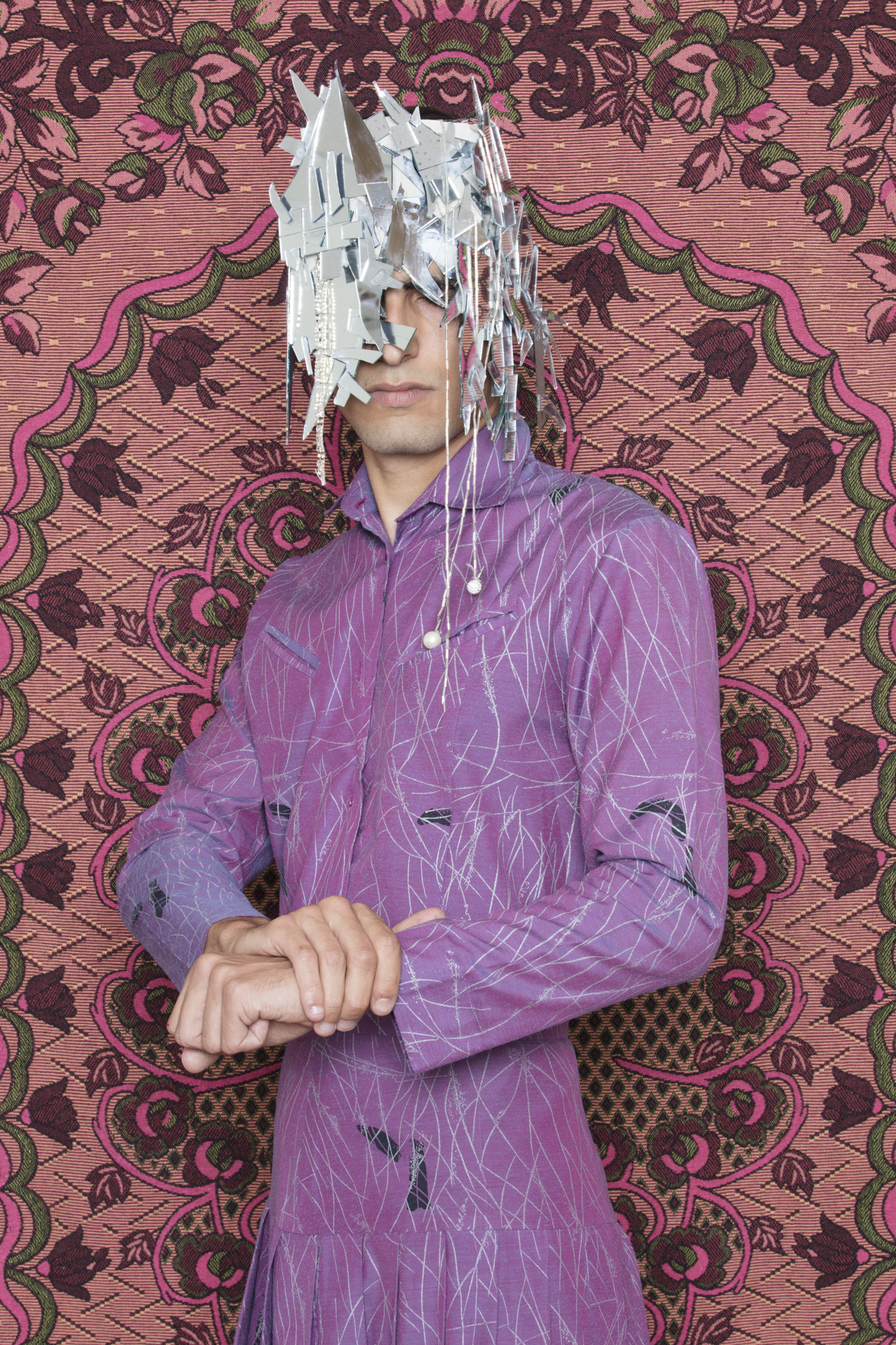




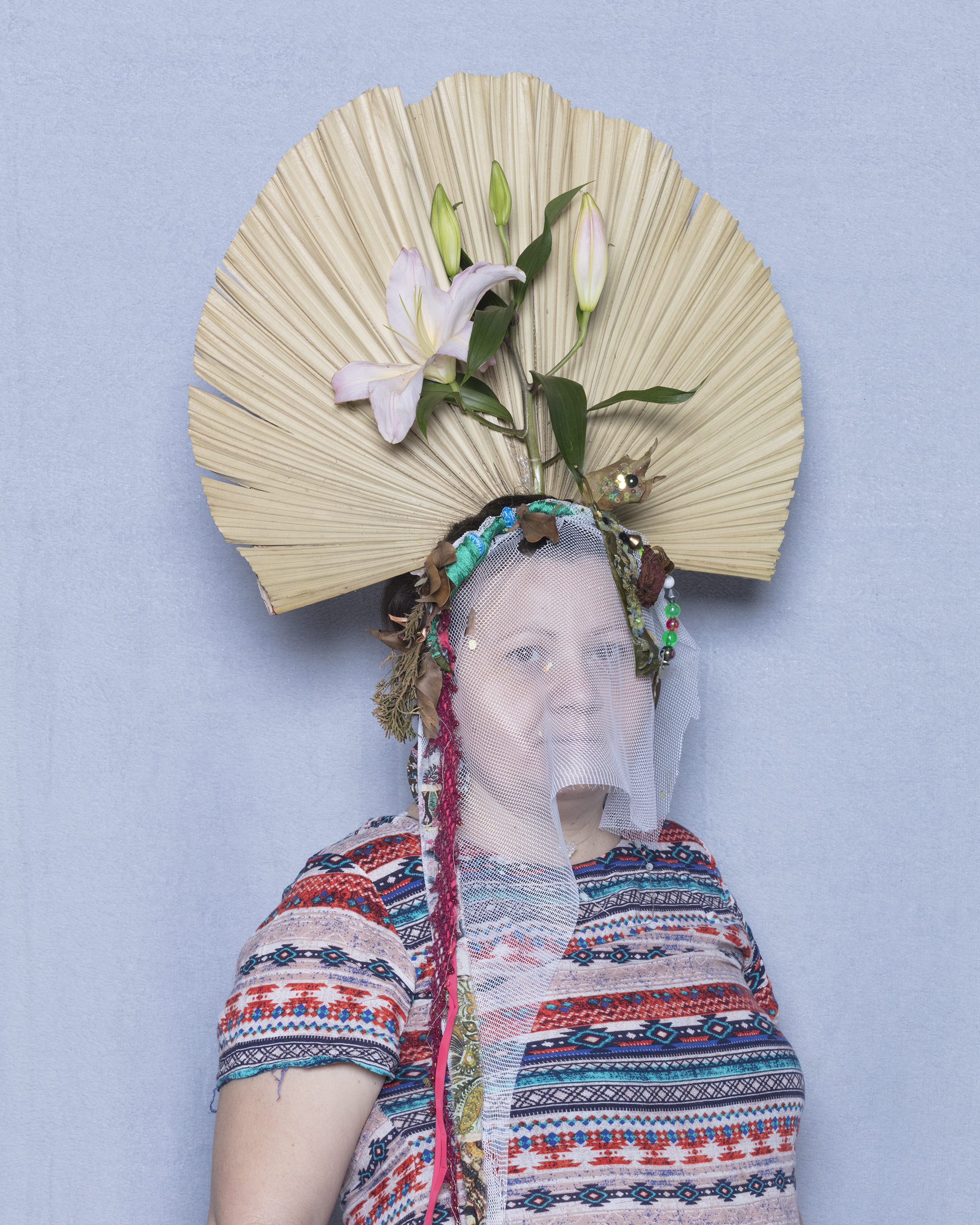
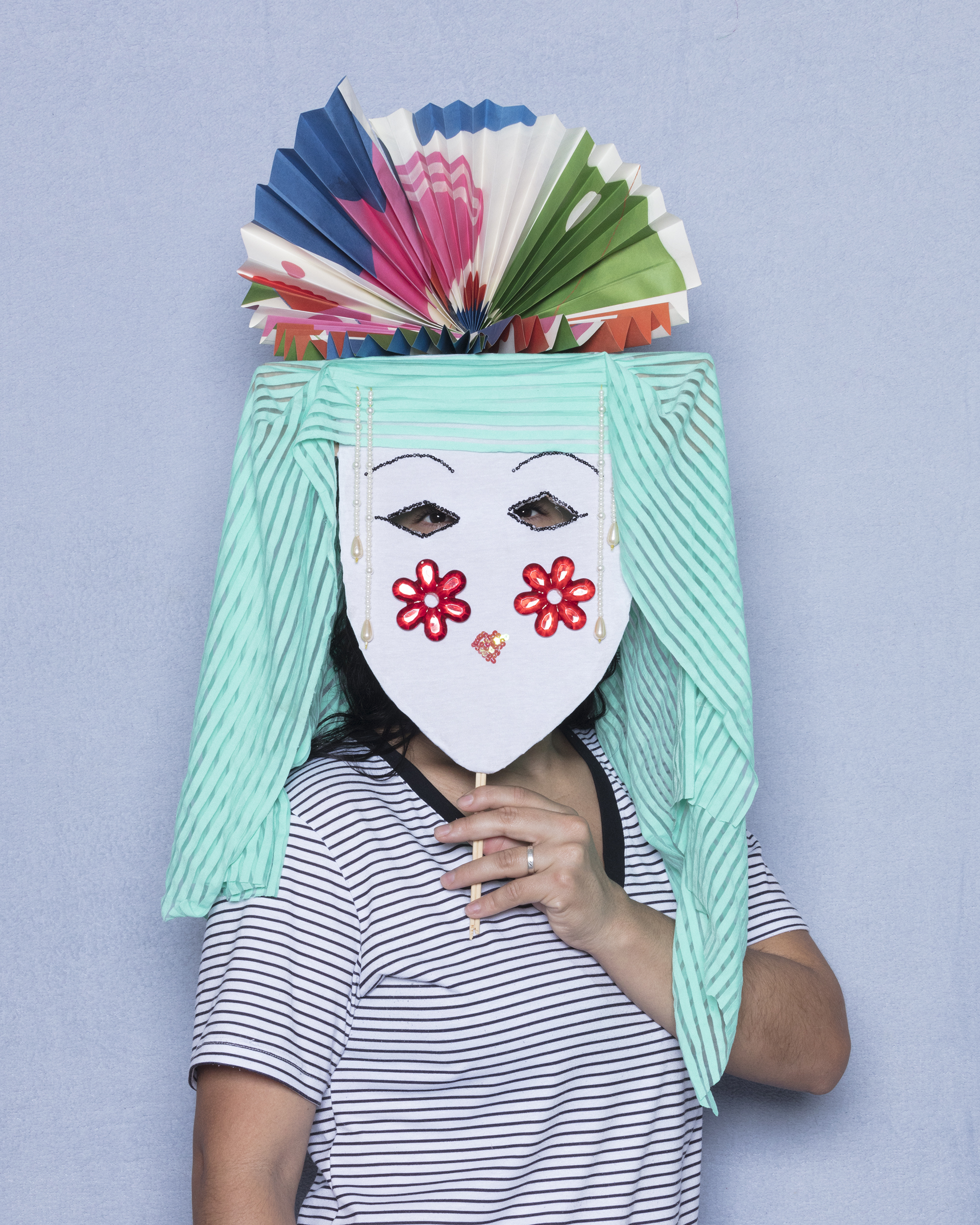




The idea was to turn these experiences into something collective, bringing to the public arena that which belongs to the private and domestic sphere, strengthening our presence and returning the notion that a self-aware body can develop the possibility to generate freedom, autonomy, and even joy.
The appearance of each image constructed depends on the collaboration of the woman portrayed — after a long process of group work, we made our own masks and developed the gestures for the photographs, bringing in domestic elements such as towels, sheets, and blankets to serve as backdrops — creating the necessary space to process the traumatic experiences.
I Am Many is the outcome of this process on photography.
For safety, all the women were guaranteed anonymity.
*developed in Casa do Povo/2014, Serviço de Assistência Social à Família/2015m Oficina Cultural Alfredo Volpi/2017
photography
since 2014
giclee print
100 x 70 cm each
since 2014
giclee print
100 x 70 cm each


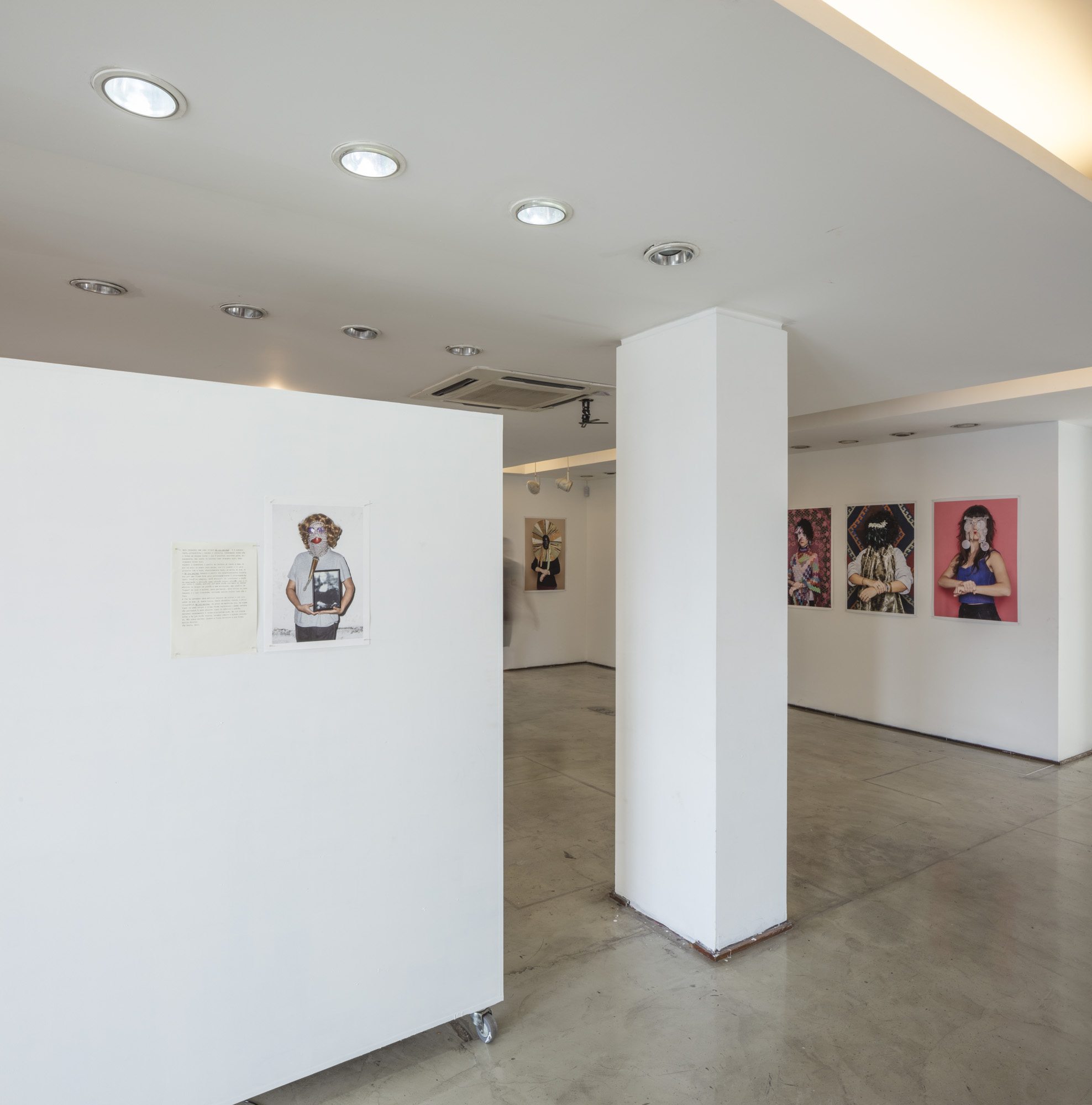
BLOODY RED
Blood-red is a photograph in which I portray my parents with their faces, hair, and necks painted red.
She/he are dressed in urban western clothes, also in red tones. .
My mother is a woman born and raised in Sertão/Northwest
who migrated to São Paulo, where she met my father, a farmer from the countryside. They married, joined a radical evangelical church, they had four daughters and a life of many conflicts.
When I photographed them, my father had already
had suffered a stroke and depended entirely on my mother.
on my mother. During this period, because of the illness, he had developed a kindness.
This image represents a life, an encounter. Because, beyond the violence and conflict, you can also notice the meeting of their skin in the arms given in their entwined hands. There is something in it that opens up questions. One could say that
a healing process, healing as something molecular, subtle - an intersectional and micropolitically productive - a kind of teaching that establishes itself and reorganizes that which was sick, the anomaly.
This carries a certain insistence in time, between permanence and change, and establishes a ritual of self-knowledge in which to affirm oneself as the same, one must be always someone else, even if to this end it becomes necessary to visit common places such as biological heritage, ancestry, and the strange-familiar that composes us.
![]()
She/he are dressed in urban western clothes, also in red tones. .
My mother is a woman born and raised in Sertão/Northwest
who migrated to São Paulo, where she met my father, a farmer from the countryside. They married, joined a radical evangelical church, they had four daughters and a life of many conflicts.
When I photographed them, my father had already
had suffered a stroke and depended entirely on my mother.
on my mother. During this period, because of the illness, he had developed a kindness.
This image represents a life, an encounter. Because, beyond the violence and conflict, you can also notice the meeting of their skin in the arms given in their entwined hands. There is something in it that opens up questions. One could say that
a healing process, healing as something molecular, subtle - an intersectional and micropolitically productive - a kind of teaching that establishes itself and reorganizes that which was sick, the anomaly.
This carries a certain insistence in time, between permanence and change, and establishes a ritual of self-knowledge in which to affirm oneself as the same, one must be always someone else, even if to this end it becomes necessary to visit common places such as biological heritage, ancestry, and the strange-familiar that composes us.

2015
giclee print
60 x 60 cm
giclee print
60 x 60 cm
BONES OF THE SERTÃO
This is the excerpt from a letter I wrote to my mother. I invited her to read it and filmed her while doing so.
This letter relates how I faced the erasure of her Northest origins in me and also in her, and how, even after years of research, I still have not found the word that describes the experience of I having been both agent and experience of this erasure.
This letter relates how I faced the erasure of her Northest origins in me and also in her, and how, even after years of research, I still have not found the word that describes the experience of I having been both agent and experience of this erasure.
2020
7'30
Vídeo
camera: André Penteado
performer: Marluce da Silveira Barreto Girotto
7'30
Vídeo
camera: André Penteado
performer: Marluce da Silveira Barreto Girotto
dorMANCY - WHILE SLEEPING I PRODUCE SUBSTANCES
Comissioned by the project Ao ar livre, the action consisted in planting yams and turmerics in some squares of Jd. Europa/São Paulo.
1. This is the district that was built at the end of the twentieth century and was addressed to the upper class of São Paulo - which is still the case today. In it, live or own properties, politicians, ruralists, businessmen, diplomatic corps, celebrities. With an huge concentration of wealth and depopulated streets, it perfectly updates the concept of the racialized and classist capitalist colonial regime that wounded the Brazilian social field. All the streets have been named after countries or European capitals.
2. Yam is well known as one of the foods with the highest concentration of depurative assets, with detoxifying, analgesic, anti-inflammatory properties, among many others. Turmeric is a very rich and practically sacred food for the ayurvedic adepts (Indian ancestral medicine), it has various medicinal uses acting mainly on inflamed tissues.
3. Among farmers, it is said that the tubers "sleep" in winter (from May to August) and begin to sprout from September, October and November being the months of their peak. The planting of these tubers in August brings the information that they will be asleep for the next few months, but it also means that while they are asleep, they multiply their breeding power by 20,000 times (nutrients and substances) because they will need this strength to puncture the soil and sprout.
4. In early March/April, when people were able to devote themselves to isolation, it was very impacting to know that the earth changed the seismic vibration and the noises in the earth's crust decreased. A friend commented: "Imagine if all the people on the planet could step barefoot on the earth at the same time, one event would arise, one other vibration".
5. I think of healing as something molecular, subtle - an intersectional and micro politically productive space - a kind of teaching that establishes and reorganizes what was sick, the anomaly. It is not a appeasement or a closure, it is sustaining a vibration until an irresolution can become an event of another order, of the order of life.
The action is accompanied by a text:
Yam yam yam yam minimum movement, turnaround! The utter experience of now. We know. And it is because we are inhabited by a body prior to the body-life-now, and it is what it knows. It eats yams messily, this body that eats and is soothed, purging, expelling the pus that the body-life-now produces. The pus of empty choleras, of games of me and them, of relational powers.
We, the yam-body and the pus-body, demand the words and our drool is pure soft chewable matter in our mouths and on our tongues. Words sink through our flesh and regurgitate expanding fermented masses of live organisms. Entire pieces of life fall from our gut and forge their way in the dirt. We spit far and we spit near, we trace routes and paths. We spit in the earth our inflammations and in return it gives us immense plants with their red, purple, black sap that seeps over our bodies. The yam-body and the pus-body. We are now many, we are plants and, together, we cure ourselves.
1. This is the district that was built at the end of the twentieth century and was addressed to the upper class of São Paulo - which is still the case today. In it, live or own properties, politicians, ruralists, businessmen, diplomatic corps, celebrities. With an huge concentration of wealth and depopulated streets, it perfectly updates the concept of the racialized and classist capitalist colonial regime that wounded the Brazilian social field. All the streets have been named after countries or European capitals.
2. Yam is well known as one of the foods with the highest concentration of depurative assets, with detoxifying, analgesic, anti-inflammatory properties, among many others. Turmeric is a very rich and practically sacred food for the ayurvedic adepts (Indian ancestral medicine), it has various medicinal uses acting mainly on inflamed tissues.
3. Among farmers, it is said that the tubers "sleep" in winter (from May to August) and begin to sprout from September, October and November being the months of their peak. The planting of these tubers in August brings the information that they will be asleep for the next few months, but it also means that while they are asleep, they multiply their breeding power by 20,000 times (nutrients and substances) because they will need this strength to puncture the soil and sprout.
4. In early March/April, when people were able to devote themselves to isolation, it was very impacting to know that the earth changed the seismic vibration and the noises in the earth's crust decreased. A friend commented: "Imagine if all the people on the planet could step barefoot on the earth at the same time, one event would arise, one other vibration".
5. I think of healing as something molecular, subtle - an intersectional and micro politically productive space - a kind of teaching that establishes and reorganizes what was sick, the anomaly. It is not a appeasement or a closure, it is sustaining a vibration until an irresolution can become an event of another order, of the order of life.
The action is accompanied by a text:
Yam yam yam yam minimum movement, turnaround! The utter experience of now. We know. And it is because we are inhabited by a body prior to the body-life-now, and it is what it knows. It eats yams messily, this body that eats and is soothed, purging, expelling the pus that the body-life-now produces. The pus of empty choleras, of games of me and them, of relational powers.
We, the yam-body and the pus-body, demand the words and our drool is pure soft chewable matter in our mouths and on our tongues. Words sink through our flesh and regurgitate expanding fermented masses of live organisms. Entire pieces of life fall from our gut and forge their way in the dirt. We spit far and we spit near, we trace routes and paths. We spit in the earth our inflammations and in return it gives us immense plants with their red, purple, black sap that seeps over our bodies. The yam-body and the pus-body. We are now many, we are plants and, together, we cure ourselves.
2020
performance
40'
performance
40'







![]()
Letter to the future
In the Portuguese language, gender is usually indicated by the letter at the end of the word: a for feminine and o for masculine. In Letter to the future, I write a letter in which all the words are in the feminine gender.
2022
lecture performance
Ocupação Nove de Julho
lecture performance
Ocupação Nove de Julho
ONLY IF THEY FALL ME ASLEEP
Created with basis on the reflections that emerged from a visit to Documenta 14 (2017), which aimed to undertake a historical decolonial revision, this work is a piece in three movements: the age of stone, the age of the mountain, and the age of dance. The entire work was based on weekly encounters of the artist with a group of elderly ballroom dancers, most of whom were visually impaired.
In Only if They Fall Me Asleep, the artist invokes the emphasis upon the visual system used in the West, which favors retinal vision over other manners of capturing/experiencing reality. The work adopts as a strategy the broadening of forms of touch and presence, aiming at helping us to perceive the relationships/perceptions that might emerge in these encounters.
The age of stone is a 60-minute eutony practice. Assisted by vocal instructions, the dancers experience the molecular movements and information of their own bodies: the sound of their breathing, the size of their liver, the bones that connect with the floor, and many others. The public enters the exhibition space in the 45th minute, witnessing the end of this movement.
In the age of the mountain, there is a search for the relationship between bodies and geological eras, and the possibility of establishing contact and movement through touch.
In the age of dance, the dancers move alone or together, while listening to different music through headphones; at the same time, the artist, accompanied by a musician, sings a single verse of the song Vapor Barato, by Jards Macalé and Waly Salomão: Oh, sim, eu estou tão cansada (Oh, yes, I am so tired).
In Only if They Fall Me Asleep, the artist invokes the emphasis upon the visual system used in the West, which favors retinal vision over other manners of capturing/experiencing reality. The work adopts as a strategy the broadening of forms of touch and presence, aiming at helping us to perceive the relationships/perceptions that might emerge in these encounters.
The age of stone is a 60-minute eutony practice. Assisted by vocal instructions, the dancers experience the molecular movements and information of their own bodies: the sound of their breathing, the size of their liver, the bones that connect with the floor, and many others. The public enters the exhibition space in the 45th minute, witnessing the end of this movement.
In the age of the mountain, there is a search for the relationship between bodies and geological eras, and the possibility of establishing contact and movement through touch.
In the age of dance, the dancers move alone or together, while listening to different music through headphones; at the same time, the artist, accompanied by a musician, sings a single verse of the song Vapor Barato, by Jards Macalé and Waly Salomão: Oh, sim, eu estou tão cansada (Oh, yes, I am so tired).
2017/2018
performance
3 hours
performers: Sonia Maria Silvestre, Marlene Cordelia, Zelia Araujo dos Santos, Madalena Ligia Coutinho dos Reis, Regina Celia de Faria Ferreira, Teresa Riello, Benjamin Orlandi, Joel Souza Leal, Walter Roberto Cirillo, Giba Duarte, Aparecido Silvestre.
music: Kilsen Girotto na Casa do Povo e Carla Boregas na SP-Arte
body perception: Ana Dupas
make-up: Felipe Ramirez
voice: Camila Valones
fotos e câmera: Adima Macena, André Penteado
edição de vídeo: Pedro Gallego
performance
3 hours
performers: Sonia Maria Silvestre, Marlene Cordelia, Zelia Araujo dos Santos, Madalena Ligia Coutinho dos Reis, Regina Celia de Faria Ferreira, Teresa Riello, Benjamin Orlandi, Joel Souza Leal, Walter Roberto Cirillo, Giba Duarte, Aparecido Silvestre.
music: Kilsen Girotto na Casa do Povo e Carla Boregas na SP-Arte
body perception: Ana Dupas
make-up: Felipe Ramirez
voice: Camila Valones
fotos e câmera: Adima Macena, André Penteado
edição de vídeo: Pedro Gallego














RED
In Red, the artist’s work invents a transitional culture that correlates family history, art, fiction, and materialities.
After living through a traumatic and violent experience, the artist painted parts of her home and all of the doors red.
This gesture sought to emulate protection and warmth in her surroundings and extended to her own body.
To this initial gesture of protection and warmth was added the desire to identify people and objects that were important in her life — including her own parents —and painting them also red, serving as an existential bookmark.
This carries a certain insistence in time, between permanence and change, and establishes a ritual of self-knowledge, in which to affirm oneself as the same, one must be always someone else.
After living through a traumatic and violent experience, the artist painted parts of her home and all of the doors red.
This gesture sought to emulate protection and warmth in her surroundings and extended to her own body.
To this initial gesture of protection and warmth was added the desire to identify people and objects that were important in her life — including her own parents —and painting them also red, serving as an existential bookmark.
This carries a certain insistence in time, between permanence and change, and establishes a ritual of self-knowledge, in which to affirm oneself as the same, one must be always someone else.
2015
photo print on cotton paper
60 x 42 cm
photo print on cotton paper
60 x 42 cm
THE NAP
The Nap is the result of a workshop carried out during an artistic residence at the Museumsquartier, in Viena/2015.
The workshop brought an opportunity to think about the manners of perceiving and experiencing reality, with an emphasis on the body as the destination of sensations, electing vision as the only means of material interpretation. These are concepts well produced in the West and replicated by art institutions.
The artist proposed that participants should sleep for two hours in the main entrance of the Leopold Museum.
To sleep is an everyday gesture that produces a different body, a mysterious one. Sleep has aspects that defy science, but we know that, to enter it, the human psyche must dismantle the forces of ego, abandoning the operationality and efficiency of rational execution. In the state of sleep, what takes over is a body that produces images and sensations with no obvious connection to reality.
The Nap attempts to reveal the operations present inside and around the museum — the monumentality, the asepsis, the ostensive security, the many doors — in order to denounce the type of body that is summoned to enter these environments: overly programmed and with an efficiency that responds to this game of representations.
To sleep sets in perspective that which is not represented, which is not monumental, which acts by molecularity. That which does not allow itself to be easily captured: the invisible and intangible that form in an unconscious and imaginary manner in dreams, becoming the source of new images in daily life.
The workshop brought an opportunity to think about the manners of perceiving and experiencing reality, with an emphasis on the body as the destination of sensations, electing vision as the only means of material interpretation. These are concepts well produced in the West and replicated by art institutions.
The artist proposed that participants should sleep for two hours in the main entrance of the Leopold Museum.
To sleep is an everyday gesture that produces a different body, a mysterious one. Sleep has aspects that defy science, but we know that, to enter it, the human psyche must dismantle the forces of ego, abandoning the operationality and efficiency of rational execution. In the state of sleep, what takes over is a body that produces images and sensations with no obvious connection to reality.
The Nap attempts to reveal the operations present inside and around the museum — the monumentality, the asepsis, the ostensive security, the many doors — in order to denounce the type of body that is summoned to enter these environments: overly programmed and with an efficiency that responds to this game of representations.
To sleep sets in perspective that which is not represented, which is not monumental, which acts by molecularity. That which does not allow itself to be easily captured: the invisible and intangible that form in an unconscious and imaginary manner in dreams, becoming the source of new images in daily life.
2015
120'
performance
door of the Leopold Museum / Vienna, Austria
participants: Alice Ursini, Guilherme Mata, Luisa Lobo, Valentin Aigner, Anastasia Soutormina, Nancy Wanderberg, Tatiana Bereza.
120'
performance
door of the Leopold Museum / Vienna, Austria
participants: Alice Ursini, Guilherme Mata, Luisa Lobo, Valentin Aigner, Anastasia Soutormina, Nancy Wanderberg, Tatiana Bereza.





MUTED POEM
A pile of rocks is covered by fabric; the stitching is apparent and irregular. Each stone carries a word. Originally, together, they formed a text titled Silenced Poem. Typed sheets set beside the rocks repeat the text. But it cannot be read: the paragraphs are covered by lines of pen that transform the calligraphy into drawings. Except for the last. It reads: "A scream expelled by open throat; one must open the tap, let the stream spill out, the water swallow the mouth in the act of forming the word. The water needs to invade the entire mouth so that the word produced there is entirely diluted. This is not a word that needs to be born, it’s a word that needs to die".
The silencing imposed upon the words hidden on the stones is repeated and reiterated again, present in violent and abusive relationships. To repeat this silencing, making only the last paragraph public, suggests the relationship between the right to words and to life. And also, the opposite: that words, as the hegemonic language, can carry death sentences, by burying images, meanings, lapses, unconscious productions.
The number of pages piled up corresponds to the number of the artist’s attempts at reproducing the poem without making typing errors.
The silencing imposed upon the words hidden on the stones is repeated and reiterated again, present in violent and abusive relationships. To repeat this silencing, making only the last paragraph public, suggests the relationship between the right to words and to life. And also, the opposite: that words, as the hegemonic language, can carry death sentences, by burying images, meanings, lapses, unconscious productions.
The number of pages piled up corresponds to the number of the artist’s attempts at reproducing the poem without making typing errors.





2017
installation
stones, cloths, threads, paper
installation
stones, cloths, threads, paper
SLEEPING ON THE OFFICIAL STORY
The artist sleeps on historical monuments in Vienna: the stairs of the National Library; the Heldenplatz, right under the balcony where Hitler spoke to the Viennese people in 1938; the monument representing Mariahilfer; the stairs of the City Hall; the window of the Museum of Natural History; and the stairs of the National Art Museum.
The work is an attempt to dismantle the hegemonic forces present in these historical-political monuments and representations, not by means of a direct and efficient action, but, on the contrary, by means of an apparent inaction — a non-action.
The work is a sequel to The Nap, carried out in the same period and city, and based on the same premise: that sleep is an everyday action that produces an unknown body, placing in perspective that which is not monumental, but invisible and intangible, and which forms the unconscious and the imaginary.
The places chosen represent the crystalized strata of the official hegemonic history. The actions were carried out on different days, and the artist slept without the assistance of sleep inducers.
The work is an attempt to dismantle the hegemonic forces present in these historical-political monuments and representations, not by means of a direct and efficient action, but, on the contrary, by means of an apparent inaction — a non-action.
The work is a sequel to The Nap, carried out in the same period and city, and based on the same premise: that sleep is an everyday action that produces an unknown body, placing in perspective that which is not monumental, but invisible and intangible, and which forms the unconscious and the imaginary.
The places chosen represent the crystalized strata of the official hegemonic history. The actions were carried out on different days, and the artist slept without the assistance of sleep inducers.
2015
performance
30' each piece
Monument to Mariahilfer, Vienna / Austria
Heldenplatz, Vienna / Austria
Stairs from the National Library, Vienna / Austria
Natural History Museum, Vienna / Austria
performance
30' each piece
Monument to Mariahilfer, Vienna / Austria
Heldenplatz, Vienna / Austria
Stairs from the National Library, Vienna / Austria
Natural History Museum, Vienna / Austria


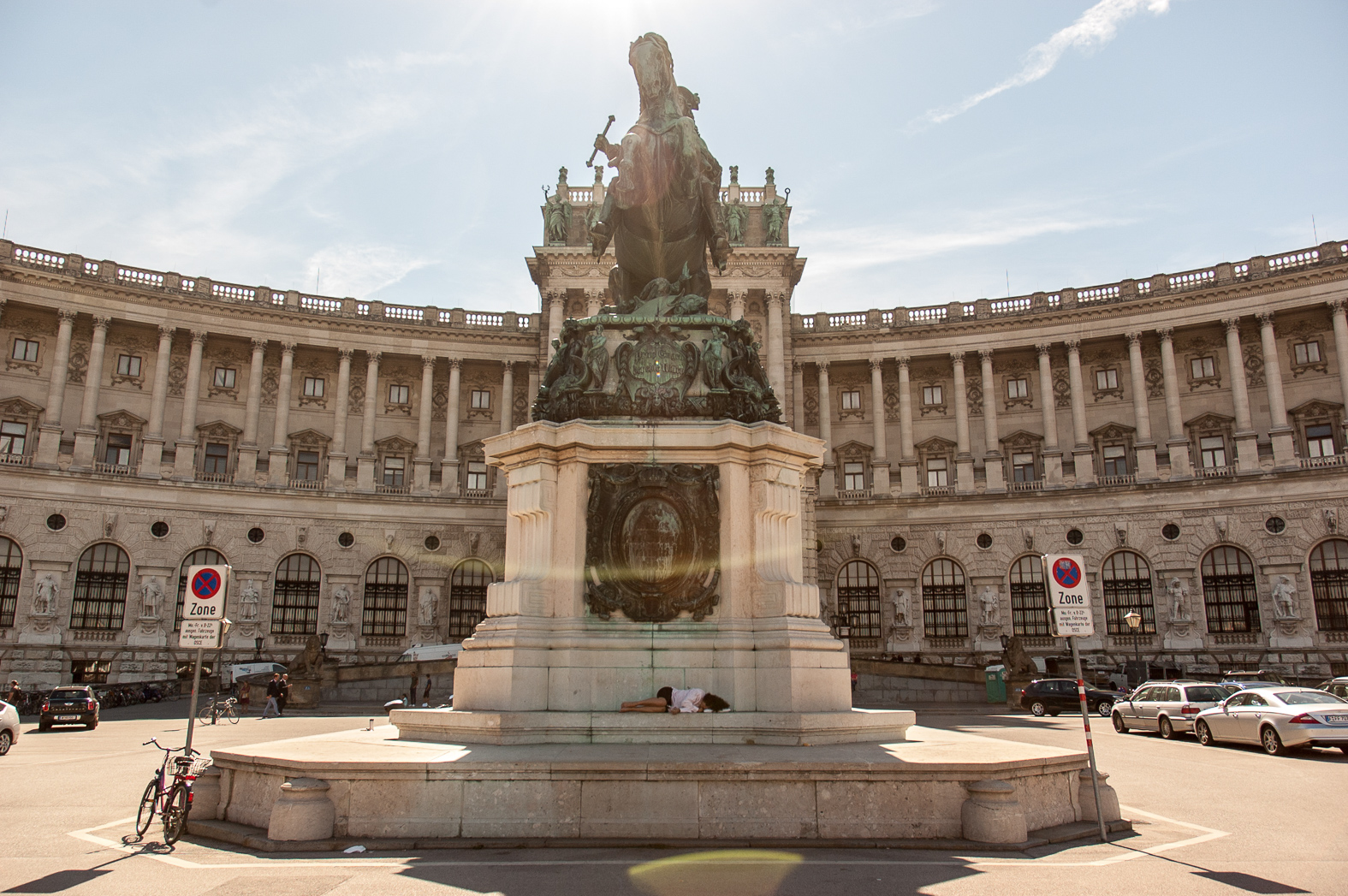








EU NÃO POSSO SENTIR POR VOCÊ MAS EU POSSO SENTIR COM VOCÊ
Criada durante residência artística no Museumsquartier, em Viena, a Eu não posso sentir por você mas posso sentir com você resulta de um workshop no qual a artista elabora, com os demais participantes, as sensações e acontecimentos que viveu desde sua chegada à cidade.
O trabalho tem três movimentos distintos. No primeiro, a artista lê para os participantes um texto em que narra suas impressões sobre a cidade e seus habitantes. No segundo, os participantes produzem máscaras e roupas. No terceiro, dançam na área pública do museu, inclusive com quem se aproxima.
Fundamentado em uma dança que pode ou não ser compartilhada, o trabalho põe em tensão as relações entre pessoas e tempo histórico, sempre uma alegoria e uma arritmia. Apontando para o fato de Viena ter protagonizado eventos tidos como vetores políticos e artísticos do mundo moderno, expõe a solidão de seus habitantes diante dos espectros históricos deste passado.
O trabalho tem três movimentos distintos. No primeiro, a artista lê para os participantes um texto em que narra suas impressões sobre a cidade e seus habitantes. No segundo, os participantes produzem máscaras e roupas. No terceiro, dançam na área pública do museu, inclusive com quem se aproxima.
Fundamentado em uma dança que pode ou não ser compartilhada, o trabalho põe em tensão as relações entre pessoas e tempo histórico, sempre uma alegoria e uma arritmia. Apontando para o fato de Viena ter protagonizado eventos tidos como vetores políticos e artísticos do mundo moderno, expõe a solidão de seus habitantes diante dos espectros históricos deste passado.
90'
performance
Museumsquartier, Vienna / Austria
partcipants: Alice Ursini, Anastasia Soutormina, Dana Sultana, Nadine, Maja, Nancy Wanderberg, Tatiana Bereza.
performance
Museumsquartier, Vienna / Austria
partcipants: Alice Ursini, Anastasia Soutormina, Dana Sultana, Nadine, Maja, Nancy Wanderberg, Tatiana Bereza.
"Something in me fell asleep when I arrived in Wien. In the first week that was not a problem at all. Even I realized that, but soon it became a little disquieting. I start to think about that kind of numbness I felt and why people seem so polite but at the same time so “deprived of feelings and keeping it up for themselves”. So, yesterday I went to Zentralfriedhof, the biggest cemetery in Europe. And then, I started to feel a sort of disorder, like an estrangement. Dead people sleeping since 1874, those monumental buildings – graves, churches – it all began to bother me. Besides, there are more people dead and buried in Wien than alive.
I caught the bus (strassesbahn) and decided to go straight to the suburbs. Surely, I was in a real city – freak people, immigrants and mothers with their babies taking a Sunday sunbath – a way of life without subterfuges.
When I arrived at the MuseumsQuartier (a very central place) we went to an Indian restaurant for dinner. And then, what happened made me lose my sleep that night. The manager accused us of not having paid. But we did, of course. We had just left the restaurant when the manager started to follow us on the street to confront us. Something in me totally shook me and I answered: well, you can call the police and we’ll resolve this in the police office. Then, he gave up and went away. I lost my sleep and regained my feelings. The most interesting thing about that experience was that the violence shook me out of my apathy.
And I realized I was like an intense resonance chamber, feeling the same kind of numbness I had felt since the beginning. Layers and layers of numbness and official history buried in the buildings and streets, surely in the bodies and lives as well, but not in the faces or gestures. Everybody seemed to be masqueraded, sleeping on the official history – a certain apathy, a kind of anesthesia, appeasement or subsidence – in other words, people with imperturbable gestures as if events would not affect them."
I caught the bus (strassesbahn) and decided to go straight to the suburbs. Surely, I was in a real city – freak people, immigrants and mothers with their babies taking a Sunday sunbath – a way of life without subterfuges.
When I arrived at the MuseumsQuartier (a very central place) we went to an Indian restaurant for dinner. And then, what happened made me lose my sleep that night. The manager accused us of not having paid. But we did, of course. We had just left the restaurant when the manager started to follow us on the street to confront us. Something in me totally shook me and I answered: well, you can call the police and we’ll resolve this in the police office. Then, he gave up and went away. I lost my sleep and regained my feelings. The most interesting thing about that experience was that the violence shook me out of my apathy.
And I realized I was like an intense resonance chamber, feeling the same kind of numbness I had felt since the beginning. Layers and layers of numbness and official history buried in the buildings and streets, surely in the bodies and lives as well, but not in the faces or gestures. Everybody seemed to be masqueraded, sleeping on the official history – a certain apathy, a kind of anesthesia, appeasement or subsidence – in other words, people with imperturbable gestures as if events would not affect them."






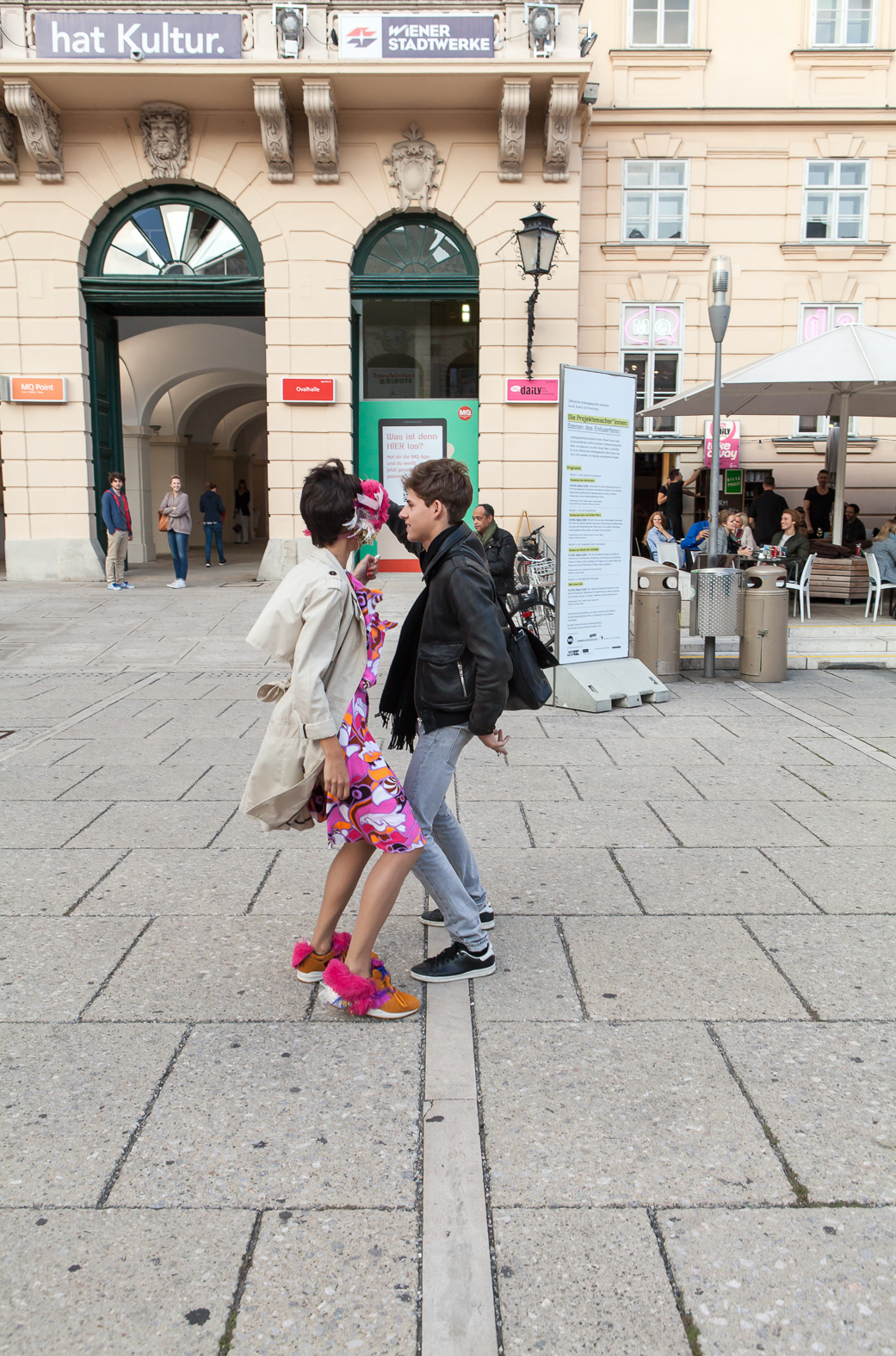







THE LOVERS
A couple dances slowly. There is no music.
During the dance, it is clear that they are joined by the elements that bind clothing and shoes (buttons, laces, and clasps), as well as by braided hair at the top of their heads.
As the dance continues, the perception of what appeared to be a caring embrace changes; it becomes clear that the two are attempting to pull apart from each other. They undo and open cuffs, waistbands, buttons; caressing hair, they untangle the common braid. Once they are completely separate, they give into their first impulse, that of running to opposite sides, forgetting their laces are still tied. The fall is inevitable.
During the dance, it is clear that they are joined by the elements that bind clothing and shoes (buttons, laces, and clasps), as well as by braided hair at the top of their heads.
As the dance continues, the perception of what appeared to be a caring embrace changes; it becomes clear that the two are attempting to pull apart from each other. They undo and open cuffs, waistbands, buttons; caressing hair, they untangle the common braid. Once they are completely separate, they give into their first impulse, that of running to opposite sides, forgetting their laces are still tied. The fall is inevitable.
2015
20'
Video
photos and video: Lucas Brandão
performers: Julia Rocha and Michel Mustafá
20'
Video
photos and video: Lucas Brandão
performers: Julia Rocha and Michel Mustafá
STRANGE DANCE
A dance contest which needs no contestants. The artist competes with herself, dancing during the entire period that the exhibition remains open to the public.
The public can interact and dance with the artist, according to instructions available at the space:
You may manipulate the artist
/ by choosing a wig, clothing item, or accessory and requesting she wear it
/ by choosing music from a playlist
/ by becoming her dance partner
The artist may manipulate you
/ by refusing to dance with you
/ by refusing or not to alter her own image
/ by choosing her own music from the playlist
/ by dancing with you until you can no longer dance
The public can interact and dance with the artist, according to instructions available at the space:
You may manipulate the artist
/ by choosing a wig, clothing item, or accessory and requesting she wear it
/ by choosing music from a playlist
/ by becoming her dance partner
The artist may manipulate you
/ by refusing to dance with you
/ by refusing or not to alter her own image
/ by choosing her own music from the playlist
/ by dancing with you until you can no longer dance
performance
Dusk, Ateliê 397, 28 days, 2015.
Open Studio, Museumsquartier, 4 hours, 2015.
SP-Arte, 5 days, 2018.
Dusk, Ateliê 397, 28 days, 2015.
Open Studio, Museumsquartier, 4 hours, 2015.
SP-Arte, 5 days, 2018.
















SILENT SCREAM WITH WIDE OPEN MOUTH
With the same yarn, starting from opposite sides, a couple knits in parallel, each creating their own clothing. To construct their outfit — they discover —they must deconstruct the other’s clothing, in a slow and infinite process.
2016
255'
performance
SESC Ipiranga, SP
performers: Carla Boregas and Gabi Vanzetta
255'
performance
SESC Ipiranga, SP
performers: Carla Boregas and Gabi Vanzetta




MATTRESS


2015
cement
190 x 80
cement
190 x 80
THE FOREIGNER
A raft suspended by balloons inhabits the aerial space above a public pool. Even though, over time, a slow approximation toward the water takes place as the balloons deflate, the object does not complete its narrative or fulfill its function.
Time is the agent of happening. Expectation is a relationship with the future, the glimpse of a possibility; it establishes a belief and demands confirmation. Success is the fulfilled expectation. The foreigner proposes an encounter of these moments: that which institutes new possibilities but, since it does not exist as a materiality, may or may not become something. In this continuous relationship, the idea of origin has no sure place.
Time is the agent of happening. Expectation is a relationship with the future, the glimpse of a possibility; it establishes a belief and demands confirmation. Success is the fulfilled expectation. The foreigner proposes an encounter of these moments: that which institutes new possibilities but, since it does not exist as a materiality, may or may not become something. In this continuous relationship, the idea of origin has no sure place.



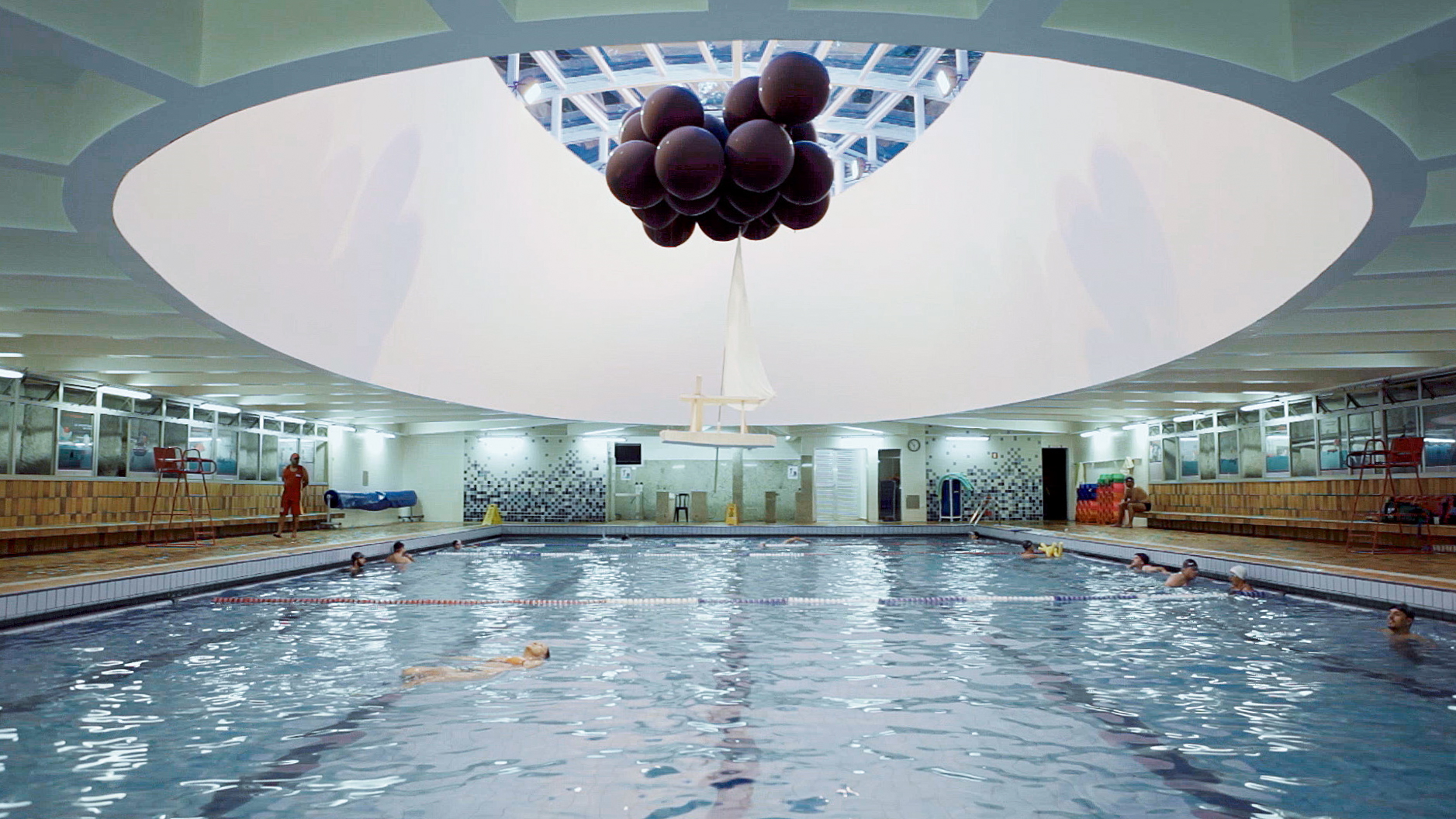
2016
installation
wood, latex, fabric, ropes and helium gas
5500 x 3400 x 2600 cm
SESC Ipiranga / The lady from the sea
photo and video: Aterro filmes
SOUNDTRACK
Eleven different soundtracks whose content allude to movie soundtracks and are named after emotions and environments: brutality, fatigue, life, joy, rapture, hunger, time, longing, love, darkness, mess. Visitors can choose one of them to be heard while watching the video The Lovers and Gloves.
There are some subtitles close to the CDs:
You can manipulate your sensations by:
- choosing a CD
- playing it
- watching the film
- repeating the operation, if you want
![]()
![]()
![]()
There are some subtitles close to the CDs:
You can manipulate your sensations by:
- choosing a CD
- playing it
- watching the film
- repeating the operation, if you want



2015
11 discs
20 x 20
Dusk, Atelier 397
audio: Ad Ferreira and Fabio Maia
11 discs
20 x 20
Dusk, Atelier 397
audio: Ad Ferreira and Fabio Maia
É IT'S VERY DIFFICULT TO HAVE A FACE

2015
installation
found object
80 x 50 cm
COMO CLUBE'S DRAWING CLUB

To intercede in the forms of constructing subjectivity is a work of constant intervention. Starting with this premise, and based on the practice of live drawing, nine performers created a collective body of work that sliced through the 31st Bienal, pushing well-defined boundaries in artistic institutions: work, public, exhibition space.
Drawing materials were distributed to the visiting public, who were invited to use these (common) tools of artistic work. Drawing the performers, the space, and the exhibited work, the public could be perceived as a sensory and material producer, and not simply as spectator or consumer.
The action was carried out in partnership with Como Clube, which existed as a physical space for artistic interaction for five years and is now a virtual platform.
2014
90'
performance in partnership with Como Clube
31st Bienal of São Paulo / SP, Brazil
photos: Matti Aikio
performers: Thelma Bonavita, Allysson Amaral, Ana Dupas, Caio César, Daniela Pinheiro, Eidglas Xavier, Gabi Vanzetta, Mavi Veloso, Valentina Desideri, Emilija Skarnulyte, Matti Aikio.
90'
performance in partnership with Como Clube
31st Bienal of São Paulo / SP, Brazil
photos: Matti Aikio
performers: Thelma Bonavita, Allysson Amaral, Ana Dupas, Caio César, Daniela Pinheiro, Eidglas Xavier, Gabi Vanzetta, Mavi Veloso, Valentina Desideri, Emilija Skarnulyte, Matti Aikio.
CRATER-BEAST


2015
installation
mirror, horn, metal, fur, photography
150 x 70 cm
installation
mirror, horn, metal, fur, photography
150 x 70 cm
MICROSCOPE
In a garden, a woman sleeps while guarded/observed by her cat. In her house, in the bathroom, ten black cats observe ten white birds that fly near the ceiling, protected by netting.
When she awakens, the woman puts on dentures and gold rings; she climbs through the window and releases the white cat in the bathroom with the cats and birds.
An agreement establishes the approaches — between the woman and the animals; between the animals themselves — and updates all the agreements of the natural order of the world. There is no mediation by the artist or the performer, but there is an alliance with the untimely.
Microscope deals with the approaches and distance between forms and forces. It investigates, by means of the action of approaching and distancing, the elements present in the performative field. That which is of the order of the visible and of representation, and therefore relates to form and can exist materially; and that which relates to forces and is a manifestation — present but impossible to materialize. This game of relations is treated as a necessary irresolution, and not as appeasement.
![]()
![]()
![]()
![]()
![]()
![]()
![]()
When she awakens, the woman puts on dentures and gold rings; she climbs through the window and releases the white cat in the bathroom with the cats and birds.
An agreement establishes the approaches — between the woman and the animals; between the animals themselves — and updates all the agreements of the natural order of the world. There is no mediation by the artist or the performer, but there is an alliance with the untimely.
Microscope deals with the approaches and distance between forms and forces. It investigates, by means of the action of approaching and distancing, the elements present in the performative field. That which is of the order of the visible and of representation, and therefore relates to form and can exist materially; and that which relates to forces and is a manifestation — present but impossible to materialize. This game of relations is treated as a necessary irresolution, and not as appeasement.


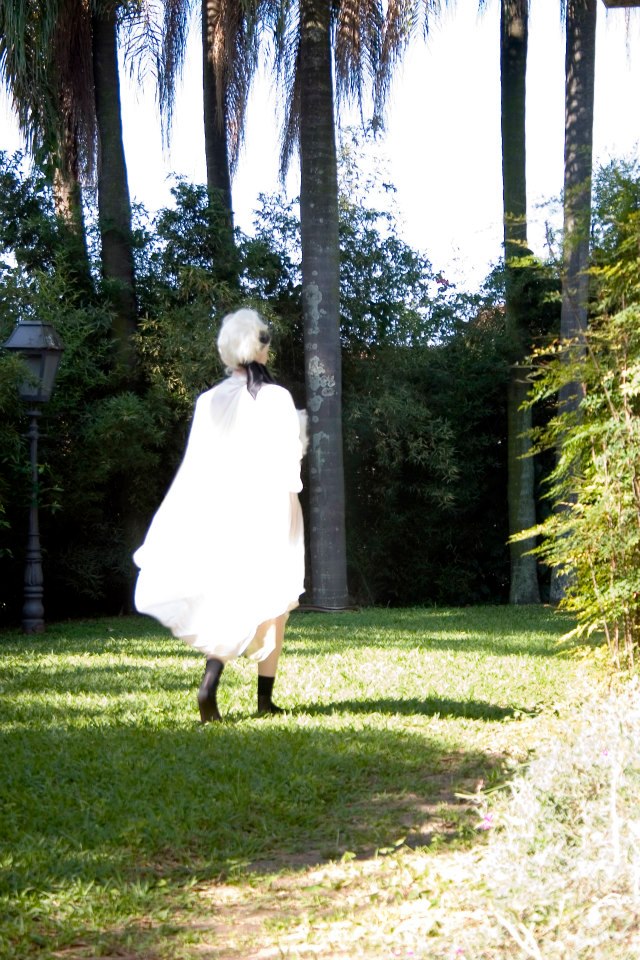




2008
40'
installation / performance
Florence Antonio Gallery
photo: Maria Antonia Demasi
40'
installation / performance
Florence Antonio Gallery
photo: Maria Antonia Demasi
LIBRARY
A collection of several books and materials, mainly fabrics, collected over 20 years.
![]()
![]()
![]()
![]()
![]()
![]()






2014/2015
objects
objects
G>E GROUP BEYONG ME
G>E_group beyond me is an art and creation study and research group led by artist Karlla Girotto.
Within the context of its production, the group is a mechanism that establishes relations between artistic dialogues, experiments with processes, and functions as a territorial base for collective movements.
Created in 2013, the group emerged from the desire to construct an environment for experimentation that was open to new ways to produce and encounter. It has as basis a common interest in unravelling hegemonic narratives and producing political-aesthetic subjectivities.
The investigations manifest by means of a policy of imagination. The word policy refers to the discussion on how to organize resources, practices, spaces, and a shared life; imagination speaks of the aim of forming ideas and creating worlds, seeking the necessary means to maintain the potential of creation alive, and searching for active positions that allow the establishment of these forces in the world.
Territories and subjectivity are constructed within a dynamic that is completely open and alive, gathering the work of each participant together with the group’s daily life. The discussions are the effects of readings in movement, especially feminist texts or those from the global south, or of political and everyday situations, besides web content.
The group identifies with the disruptive potential of non-hegemonic art and life and believes in making experiences collective as a strategy to generate freedom and autonomy.
The fixed programs include weekly collective meetings; individual mentoring by artist Karlla Girotto; and the G>E Open Heart, which brings in guest artists every two months to debate processes and creation.
G>E OPEN HEART
A program by G>E that invites artists and researchers who wish to publicly share their processes.
Guest artists and researchers who have attended G>E Open Heart include: Paula Garcia, Beatriz Lemos, Maurício Ianês, Bruno Faria, André Penteado, Gabriela Serfaty, Felipe Russo, Icaro Lira, Nino Cais, Crioulla Oliveira, Daniel Jablonski, Flora Leite, Tarcísio de Almeida, Andrea Mendes, Thelma Bonavita, Bruna Petreca, Rodolfo Beltrão, Ad Ferrera, Ana Dupas, Allysson Amaral, Bianca Soares, Bruno Mendonça, Jjoao Paes, Caio, Camila Valones, Carla Boregas, Carlos Monroy, Carou Diquinson, Bruna Kury, Karen Ka, Catarina Duncan, Deusydara, Erica Malunguinho, Erika Palomino, Felipe Caprestano, Glamour Garcia, Josefa Pereira, Juliana França, Thelma Bonavita, Karlla Girotto, KK Toy, Morgana Apuama, Pedro Gallego, Renata Bastos, Ricardo Càstro, Rodrigo Vaz, Ronalda Bi, Suzy Okamoto, Teresa Siewerdt, Pablo Paniagua, TintaPreta, Thiane Nascimento, Veniccio Barbosa, Vicente Perrota, Xu.
G>E Open Heart happens in three different formats: an individual conversation with the artist/researcher; round tables; and the Special Edition, gathering several artists in a plurality of actions and contents.
The program is always planned as an autonomous and independent event, carried out in partnership with the participating artists. This means breaking with certain institutional hegemonies that favor project over process.
The idea is to create other forms of production of knowledge, revealing processes and epistemologies, directing and revealing the (un)known reality. It is not a manifest due to its precarity, but due to the potential that inhabits a work, independent of the processes and productions that might sculpt it.
Within the context of its production, the group is a mechanism that establishes relations between artistic dialogues, experiments with processes, and functions as a territorial base for collective movements.
Created in 2013, the group emerged from the desire to construct an environment for experimentation that was open to new ways to produce and encounter. It has as basis a common interest in unravelling hegemonic narratives and producing political-aesthetic subjectivities.
The investigations manifest by means of a policy of imagination. The word policy refers to the discussion on how to organize resources, practices, spaces, and a shared life; imagination speaks of the aim of forming ideas and creating worlds, seeking the necessary means to maintain the potential of creation alive, and searching for active positions that allow the establishment of these forces in the world.
Territories and subjectivity are constructed within a dynamic that is completely open and alive, gathering the work of each participant together with the group’s daily life. The discussions are the effects of readings in movement, especially feminist texts or those from the global south, or of political and everyday situations, besides web content.
The group identifies with the disruptive potential of non-hegemonic art and life and believes in making experiences collective as a strategy to generate freedom and autonomy.
The fixed programs include weekly collective meetings; individual mentoring by artist Karlla Girotto; and the G>E Open Heart, which brings in guest artists every two months to debate processes and creation.
G>E OPEN HEART
A program by G>E that invites artists and researchers who wish to publicly share their processes.
Guest artists and researchers who have attended G>E Open Heart include: Paula Garcia, Beatriz Lemos, Maurício Ianês, Bruno Faria, André Penteado, Gabriela Serfaty, Felipe Russo, Icaro Lira, Nino Cais, Crioulla Oliveira, Daniel Jablonski, Flora Leite, Tarcísio de Almeida, Andrea Mendes, Thelma Bonavita, Bruna Petreca, Rodolfo Beltrão, Ad Ferrera, Ana Dupas, Allysson Amaral, Bianca Soares, Bruno Mendonça, Jjoao Paes, Caio, Camila Valones, Carla Boregas, Carlos Monroy, Carou Diquinson, Bruna Kury, Karen Ka, Catarina Duncan, Deusydara, Erica Malunguinho, Erika Palomino, Felipe Caprestano, Glamour Garcia, Josefa Pereira, Juliana França, Thelma Bonavita, Karlla Girotto, KK Toy, Morgana Apuama, Pedro Gallego, Renata Bastos, Ricardo Càstro, Rodrigo Vaz, Ronalda Bi, Suzy Okamoto, Teresa Siewerdt, Pablo Paniagua, TintaPreta, Thiane Nascimento, Veniccio Barbosa, Vicente Perrota, Xu.
G>E Open Heart happens in three different formats: an individual conversation with the artist/researcher; round tables; and the Special Edition, gathering several artists in a plurality of actions and contents.
The program is always planned as an autonomous and independent event, carried out in partnership with the participating artists. This means breaking with certain institutional hegemonies that favor project over process.
The idea is to create other forms of production of knowledge, revealing processes and epistemologies, directing and revealing the (un)known reality. It is not a manifest due to its precarity, but due to the potential that inhabits a work, independent of the processes and productions that might sculpt it.
since 2013
research and studies about art and creation processe
research and studies about art and creation processe






















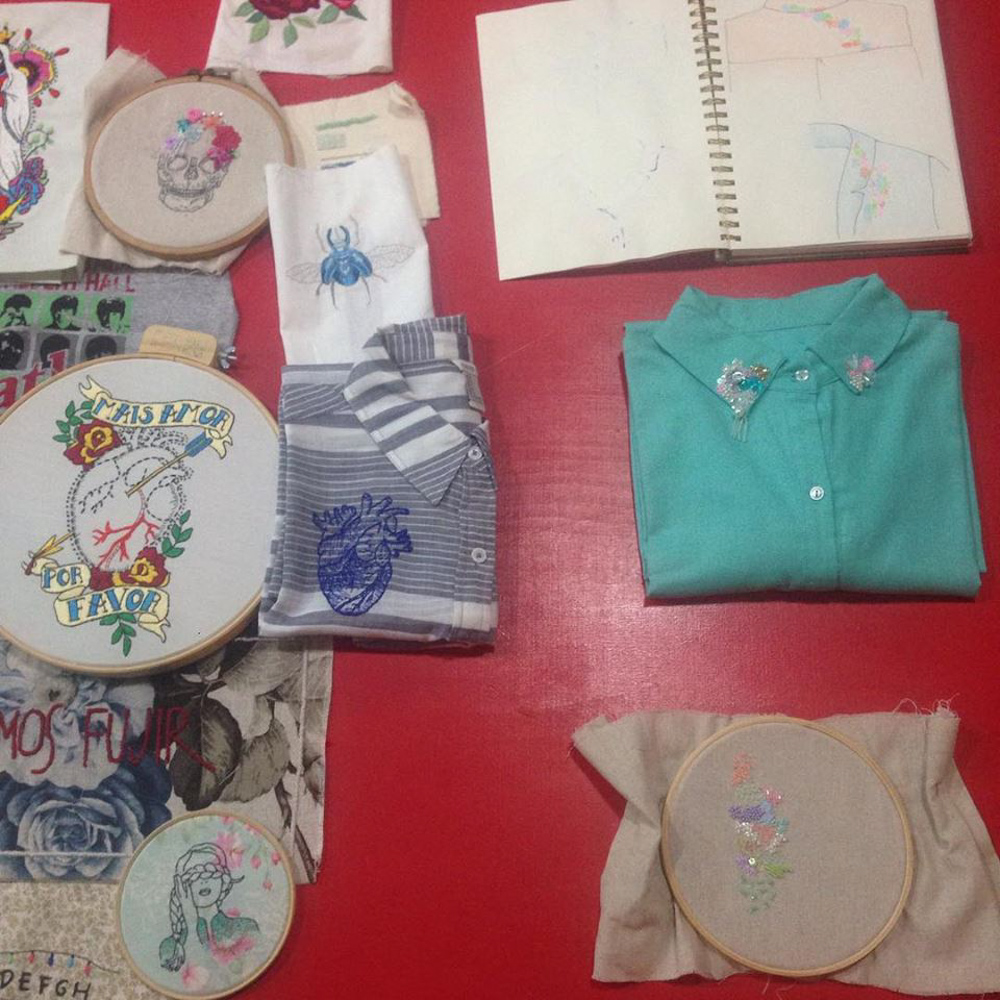








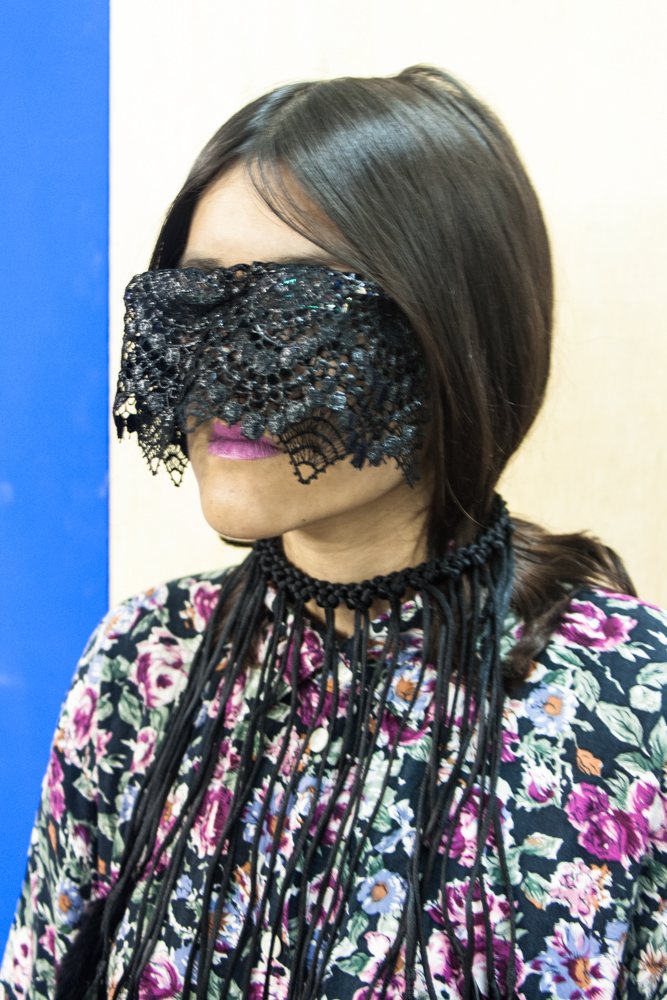




G>E OPEN HEART SPECIAL EDITION 2019
A program by G>E_group beyond me that invites artists and researchers who wish to publicly share their processes.
G>E Open Heart happens in three different formats: an individual conversation with the artist/researcher; round tables; and the Special Edition, gathering several artists in a plurality of actions and contents.
The program is always planned as an autonomous and independent event, carried out in partnership with the participating artists. This means breaking with certain institutional hegemonies that favor project over process.
The idea is to create other forms of production of knowledge, revealing processes and epistemologies, directing and revealing the (un)known reality. It is not a manifest due to its precarity, but due to the potential that inhabits a work, independent of the processes and productions that might sculpt it.
The special edition 2019 count on the artists bellow Alexandre dos Anjos, Ana Dupas, Bru de Figueiredo, Carolina Castanho com Jjoao Paes e Iran Giusti, Frank Dezeuxis, Gal Gruman, Laura Artigas, Marta Pires, Otavio Barata, Pedro Gallego, Sofia Lemos, Valentina Soares.
G>E Open Heart happens in three different formats: an individual conversation with the artist/researcher; round tables; and the Special Edition, gathering several artists in a plurality of actions and contents.
The program is always planned as an autonomous and independent event, carried out in partnership with the participating artists. This means breaking with certain institutional hegemonies that favor project over process.
The idea is to create other forms of production of knowledge, revealing processes and epistemologies, directing and revealing the (un)known reality. It is not a manifest due to its precarity, but due to the potential that inhabits a work, independent of the processes and productions that might sculpt it.
The special edition 2019 count on the artists bellow Alexandre dos Anjos, Ana Dupas, Bru de Figueiredo, Carolina Castanho com Jjoao Paes e Iran Giusti, Frank Dezeuxis, Gal Gruman, Laura Artigas, Marta Pires, Otavio Barata, Pedro Gallego, Sofia Lemos, Valentina Soares.
























aesthetic-political clinic_mentoring research and creation processes
Individual mentoring in processes and instauration of procedures in art. This work extends the creation modes of G>E_grupo maior que eu_ @grupupomaiorqueeu transferring some of experiences to the personal context.
G>E exists since 2013 and, quite briefly, we can say that we have been dedicated to restoration of vital and creative potency in artistic processes, establish relational territories where the unconscious can find breaches and escapes for their materialities, some artistic, others existential. Aimed at all those who have their artistic life imprisoned, for whatever reasons and in whatever ways.
The participant commits to stay for 1 semester and the meetings are individual and last 60 minutes. Currently online.
G>E exists since 2013 and, quite briefly, we can say that we have been dedicated to restoration of vital and creative potency in artistic processes, establish relational territories where the unconscious can find breaches and escapes for their materialities, some artistic, others existential. Aimed at all those who have their artistic life imprisoned, for whatever reasons and in whatever ways.
The participant commits to stay for 1 semester and the meetings are individual and last 60 minutes. Currently online.
individual mentoring
since 2018
since 2018

LIVING WORKSHOP
The Ateliê Vivo is a public library of patterns and also a laboratory of textile and fashion practices. It emerged as a proposal of G>E_group beyond me_ for the Metacoletivo project of Casa do Povo.
The Ateliê Vivo worked with G>E from 2014 to 2018. It is now a strong and autonomous project, working in its own studio managed by Andrea Guerra, Carolina Cherubini, Fábio Lima Malheiros, Flávia Lobo de Felício, Gabriela Cherubini.
The objective is that people can intervene in the logic of the fashion industry by regaining knowledge and autonomy about the construction of a clothing. The public can choose a model, cut and sew their own clothes.
The points that should be highlighted about Ateliê Vivo:
/Act in a lively and active mode in the fashion cycle;
/intervene in the logic of the fashion production process;
/manual process.
/autonomy in the construction of an outfit;
The Ateliê Vivo worked with G>E from 2014 to 2018. It is now a strong and autonomous project, working in its own studio managed by Andrea Guerra, Carolina Cherubini, Fábio Lima Malheiros, Flávia Lobo de Felício, Gabriela Cherubini.
The objective is that people can intervene in the logic of the fashion industry by regaining knowledge and autonomy about the construction of a clothing. The public can choose a model, cut and sew their own clothes.
The points that should be highlighted about Ateliê Vivo:
/Act in a lively and active mode in the fashion cycle;
/intervene in the logic of the fashion production process;
/manual process.
/autonomy in the construction of an outfit;
2015 to 2018
pattern public library
Coordenators: Andrea Guerra, Carolina Cherubini, Fábio Lima Malheiros, Flavia Lobo de Felício, Gabriela Cherubini
photos: Mariane Lima
pattern public library
Coordenators: Andrea Guerra, Carolina Cherubini, Fábio Lima Malheiros, Flavia Lobo de Felício, Gabriela Cherubini
photos: Mariane Lima









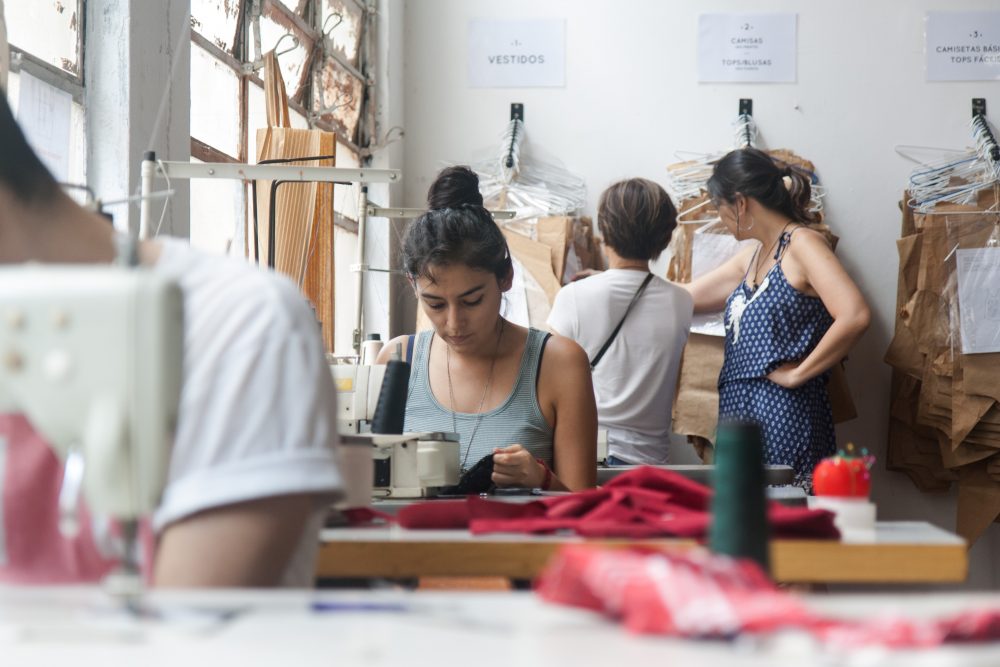

G>E OPEN HEART 2018
A program by G>E_group beyond me that invites artists and researchers who wish to publicly share their processes.
G>E Open Heart happens in three different formats: an individual conversation with the artist/researcher; round tables; and the Special Edition, gathering several artists in a plurality of actions and contents.
The program is always planned as an autonomous and independent event, carried out in partnership with the participating artists. This means breaking with certain institutional hegemonies that favor project over process.
The idea is to create other forms of production of knowledge, revealing processes and epistemologies, directing and revealing the (un)known reality. It is not a manifest due to its precarity, but due to the potential that inhabits a work, independent of the processes and productions that might sculpt it.
The special edition 2018 hosted Bruno Mendonça as curator and guest the artists bellow Ad Ferrera, Ana Dupas, Allysson Amaral, Bianca Soares, Bruno Mendonça, Jjoao Paes, Caio César de Andrade, Camila Valones, Carla Boregas, Carlos Monroy, Carou Diquinson, Bruna Kury, Karen Ka, Catarina Duncan, Deusydara, Erica Malunguinho, Erika Palomino, Felipe Caprestano, Glamour Garcia, Josefa Pereira, Juliana França, Thelma Bonavita, KK Toy, Morgana Apuama, Pedro Gallego, Renata Bastos, Ricardo Càstro, Rafa Kennedy, Rodrigo Vaz, Ronalda Bi, Suzy Okamoto, Teresa Siewerdt, Pablo Paniagua, TintaPreta, Thiane Nascimento, Veniccio Barbosa, Vicente Perrota, Xu.
G>E Open Heart happens in three different formats: an individual conversation with the artist/researcher; round tables; and the Special Edition, gathering several artists in a plurality of actions and contents.
The program is always planned as an autonomous and independent event, carried out in partnership with the participating artists. This means breaking with certain institutional hegemonies that favor project over process.
The idea is to create other forms of production of knowledge, revealing processes and epistemologies, directing and revealing the (un)known reality. It is not a manifest due to its precarity, but due to the potential that inhabits a work, independent of the processes and productions that might sculpt it.
The special edition 2018 hosted Bruno Mendonça as curator and guest the artists bellow Ad Ferrera, Ana Dupas, Allysson Amaral, Bianca Soares, Bruno Mendonça, Jjoao Paes, Caio César de Andrade, Camila Valones, Carla Boregas, Carlos Monroy, Carou Diquinson, Bruna Kury, Karen Ka, Catarina Duncan, Deusydara, Erica Malunguinho, Erika Palomino, Felipe Caprestano, Glamour Garcia, Josefa Pereira, Juliana França, Thelma Bonavita, KK Toy, Morgana Apuama, Pedro Gallego, Renata Bastos, Ricardo Càstro, Rafa Kennedy, Rodrigo Vaz, Ronalda Bi, Suzy Okamoto, Teresa Siewerdt, Pablo Paniagua, TintaPreta, Thiane Nascimento, Veniccio Barbosa, Vicente Perrota, Xu.


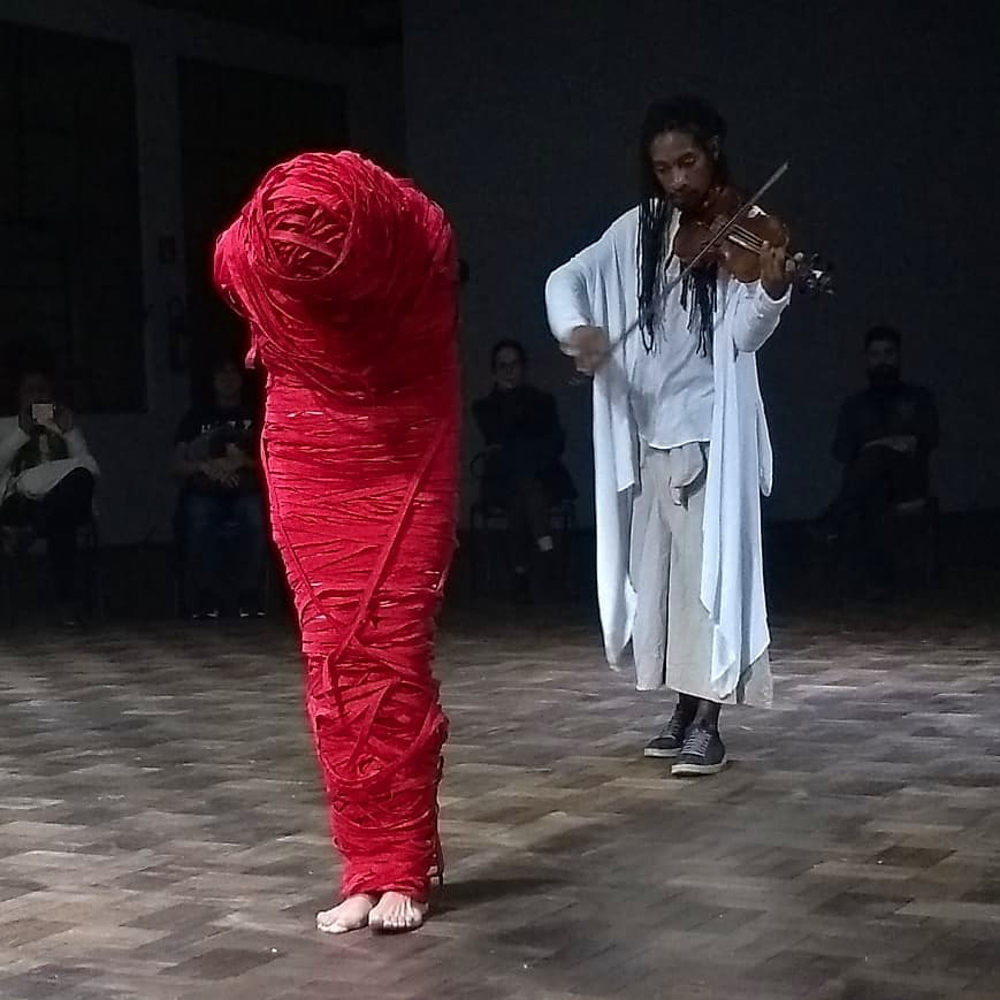


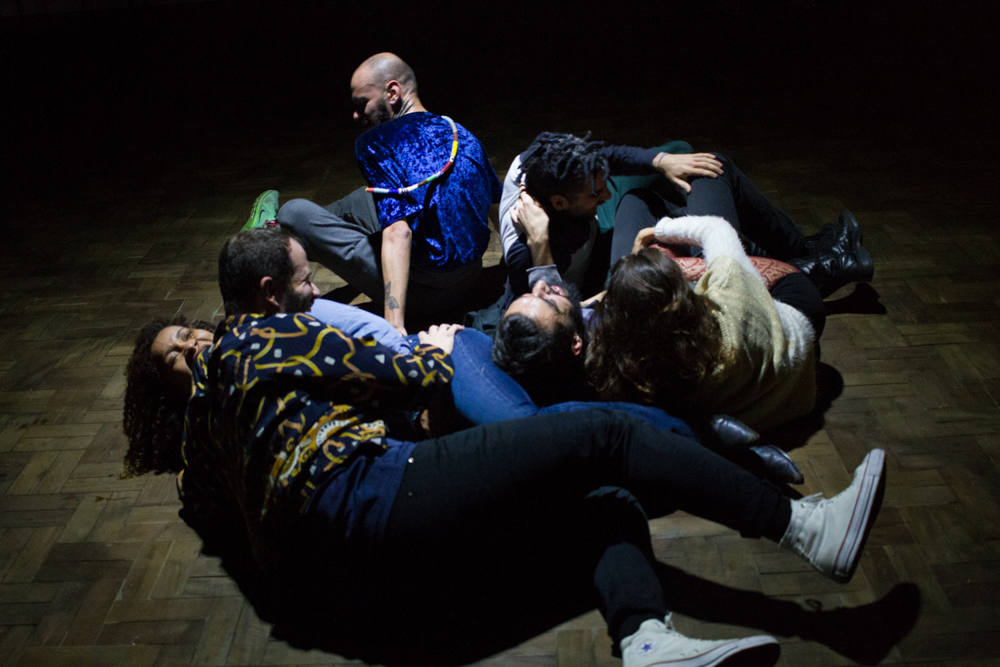
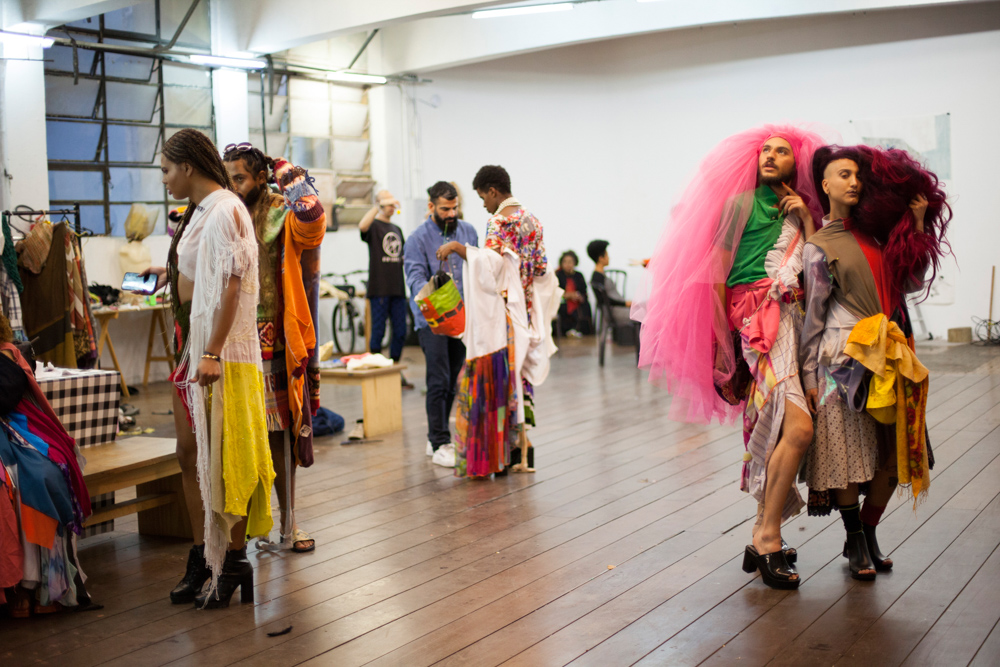

















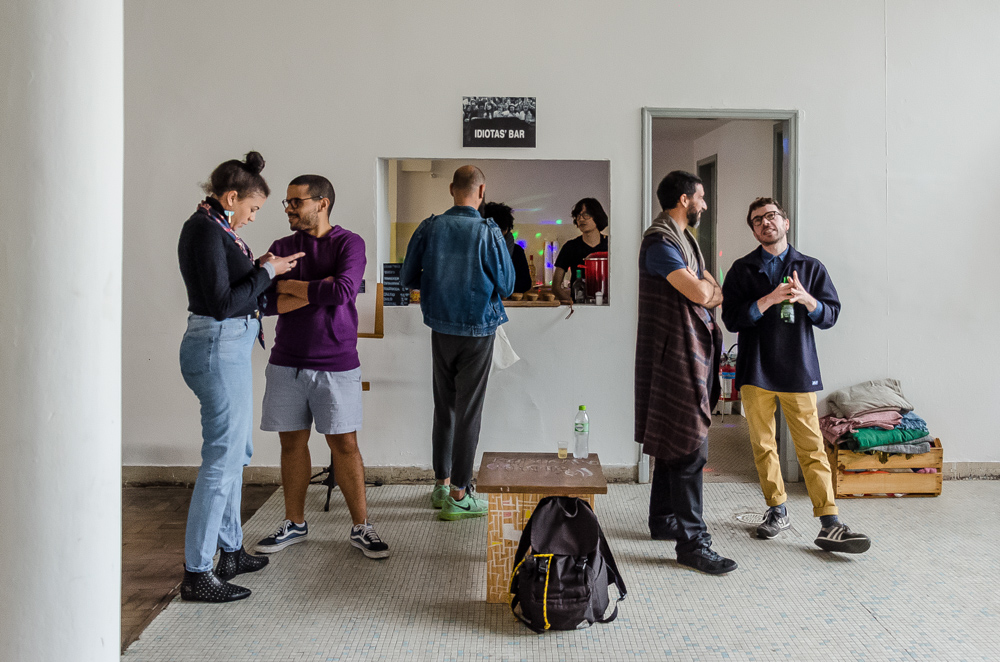










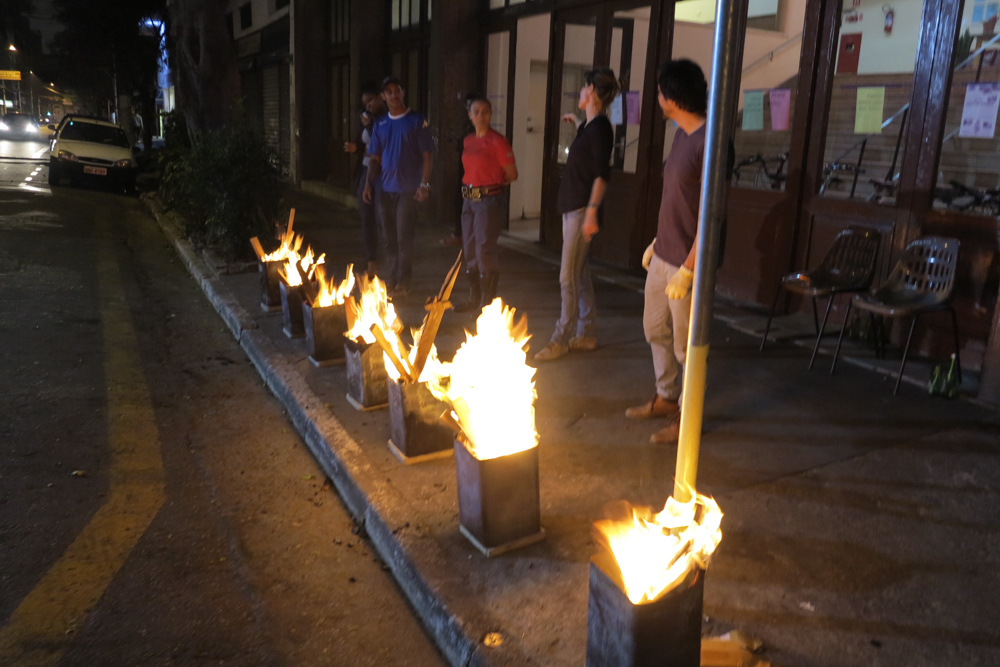

WORKSHOP OF THINGS
Carried out in partnership with artist Thelma Bonavita, based on dissemination of a workshop with the following instructions:
Workshop of Things
/ bring objects with which to create a parade of things
/ make these objects available so the other participants can use them
/ parade the objects
/ the objects and space conduct the operation.
The artists join in with the participants, and a driving organization begins to take shape. Movements appear as drawings conducted by the objects, promoting a game of resignification — of the space, of time, of the object, and of the bearer — in which the general (life) and the specific (personal history) mingle in a sensorial dynamic that shares other forms of perception.
Workshop of Things
/ bring objects with which to create a parade of things
/ make these objects available so the other participants can use them
/ parade the objects
/ the objects and space conduct the operation.
The artists join in with the participants, and a driving organization begins to take shape. Movements appear as drawings conducted by the objects, promoting a game of resignification — of the space, of time, of the object, and of the bearer — in which the general (life) and the specific (personal history) mingle in a sensorial dynamic that shares other forms of perception.
2014
240'
action in partnership with Thelma Bonavita and Casa do Povo
photo: Danielle Yukari
240'
action in partnership with Thelma Bonavita and Casa do Povo
photo: Danielle Yukari










POLISSEMY




2003
Giclee print
120 x 80 cm
photo: Henrique Gendre
in partnership with Suzy Okamoto
Giclee print
120 x 80 cm
photo: Henrique Gendre
in partnership with Suzy Okamoto
THINGS







I HAVE THE WHOLE SKY TO FLY



It is a route of about 15km that I after walked. In this time, I lived near to Galeria Vermelho, in the West of the city. This work is about origin, memory, and periphery-center displacement.
2003
00h10
performance
Galeria Vermelho
video: Vitor Angelo
MICROSCOPE II

A pair of binoculars from the 70s had their lenses altered so that when the observer looks through them, he/she sees the one word printed and an arrow pointing up. Whatever the object or place one may want to scrutinize using the binocular, there will always be a reminder propose by the word and the arrow
2008
object
object
NAME NUMBER AND SERIE
1999
installation
leather, fabric, metal
Feira Internacional de Tecido
installation
leather, fabric, metal
Feira Internacional de Tecido
INVISIBLE
A bed and a vertical coffin shelter through the night two women at the same time, as a faun runs around the outer perimeter of the gallery.
The faun’s function is to protect the women’s sleep and magnetize the “art space” with a wild and unfathomable presence, a mixture of man and beast.
There were no visitors or registering of the action.
The faun’s function is to protect the women’s sleep and magnetize the “art space” with a wild and unfathomable presence, a mixture of man and beast.
There were no visitors or registering of the action.
2004
480'
performance
Galeria Vermelho
480'
performance
Galeria Vermelho
